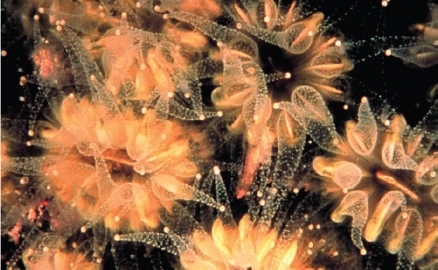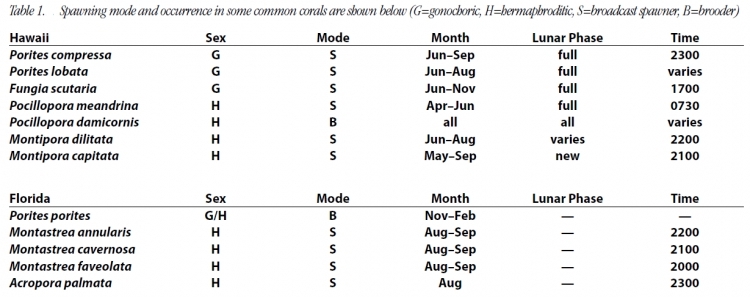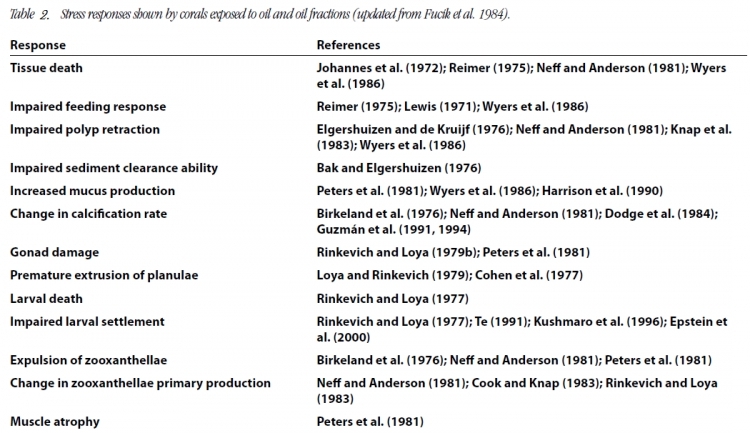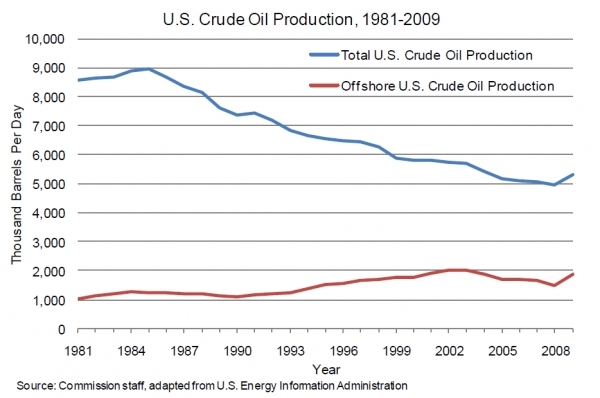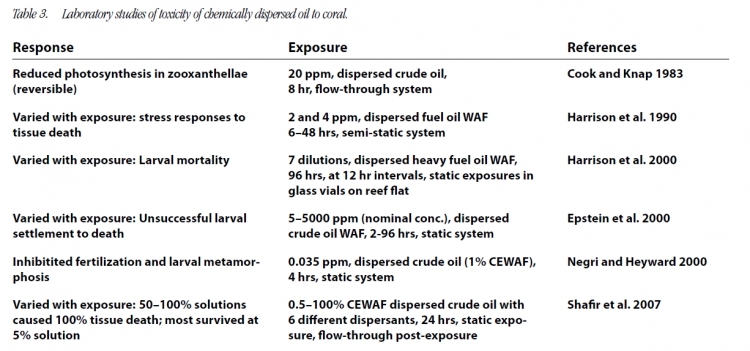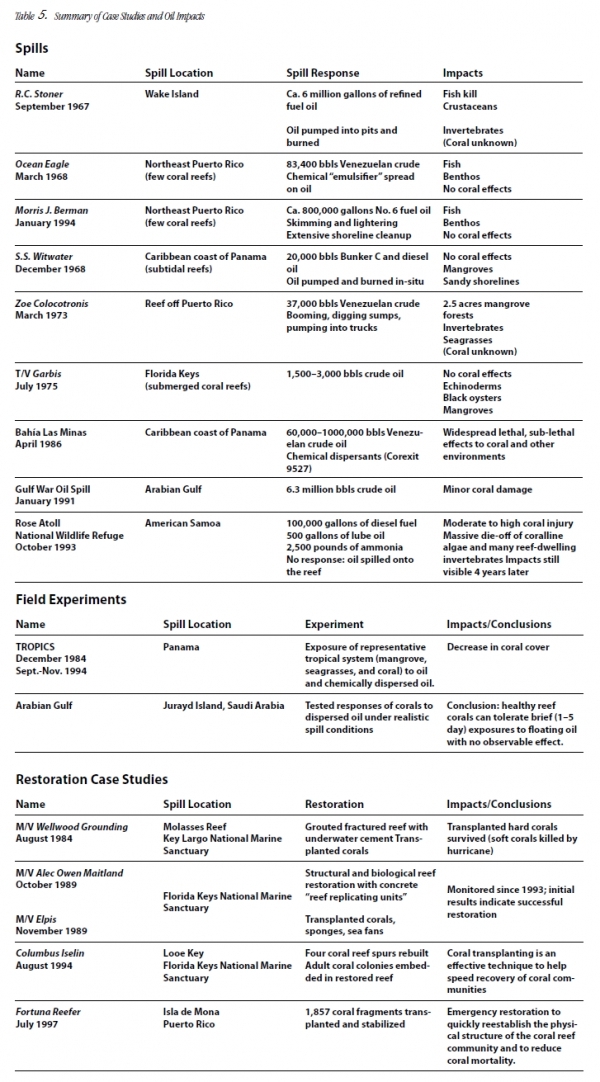Oil spills in coral reefs
Editor's Note: This article is excerpted directly from NOAA, "Oil Spills in Coral Reefs: Planning and Response Considerations, " July 2010. It has been edited only to conform to the Encyclopedia's style guidelines.
Contents
- 1 Introduction
- 2 Oil Toxicity To Corals
- 3 Response Methods For Coral Reef Areas
- 4 Coral Reef Restoration
- 5 Coral Case Studies
- 5.1 Introduction
- 5.2 Spill case studies
- 5.2.1 R. C. Stoner, Wake Island/September 1967
- 5.2.2 Ocean Eagle spill, Puerto Rico / March 1968 and Morris J. Berman, Puerto Rico / January 1994
- 5.2.3 SS Witwater spill, Panama / December 1968
- 5.2.4 Zoe Colocotronis / March 1973
- 5.2.5 T/V Garbis spill, Florida Keys / July 1975
- 5.2.6 Bahía Las Minas, Panama / April 1986
- 5.2.7 Gulf War Spill, Arabian Gulf / January 1991
- 5.2.8 Rose Atoll National Wildlife Refuge, American Samoa / October 1993
- 5.3 Field Experiment Case Studies
- 5.4 Restoration Case Studies
- 6 Glossary
- 7 Coral Websites
- 8 Further Reading
Introduction
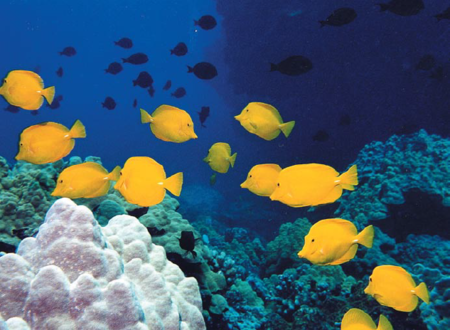 Coral habitat in the Hawaiian Islands. Credit: NOAA Coral habitat in the Hawaiian Islands. Credit: NOAA
|
This guide is intended to serve several functions and several audiences. We hope that resource agency personnel and responders of all types working in or planning for response in coral reef regions will find useful information here. It is not intended to be a specific guide for choosing cleanup methods, as many good versions of these exist already. Rather, we summarize current research on [[coral reef]s] from the perspective of those who may need to make decisions about response in these regions and present the information in an accessible format for people with some science or response background. Experienced responders unfamiliar with [[coral reef]s] may want background on coral ecology and terminology; biologists may want an overview of toxicity issues related to coral and response and cleanup applied to [[coral reef]s] in particular. We have organized the topics by chapters, each of which can be read independently, with additional references provided at the end of each chapter.
The first secton of this guide, on oil toxicity, is a current review of the research available on oil toxicity to coral. We also address how to evaluate scientific studies that attempt to measure oil toxicity in laboratories or field settings. In the next section, we discuss general guidance for responding to spills in [[coral reef]s] and provide specific considerations for open-water cleanup measures. Section three discusses the emerging science of restoration of damaged reefs and presents data on recovery patterns and rates from a variety of impacts in coral habitats. Lastly, we have compiled several case studies that illustrate a range of issues—some spill (Oil spill)s seem to have had very little impact on coral while others inflicted severe and long-lasting damage on nearshore resources. Some remote spill (Oil spill)s had long-term impacts to the entire ecosystem. On a more positive note, several cases illustrate new technologies being used to restore [[coral reef]s]. Additional resources for each of the sections are provided at the end of the document, along with a list of web sites that link to useful data on reefs. This publication is part of NOAA’s Coral Reef Conservation Program designed to protect and restore the nation’s [[coral reef]s] and assist conservation of reef [[ecosystem]s] internationally. This program includes efforts to monitor and assess coral health, map coral reef [[ecosystem]s], conduct research to better understand biological, social and economic factors which effect [[coral reef]s], partnerships to reduce the adverse affects of fishing, coastal development and pollution, and identify coral reef areas for special protection.
Oil Toxicity To Corals
- For a more in-depth look at oil toxicity and coral reefs, please see Toxicity of Oil to Reef-Building Corals: A Spill Response Perspective, NOAA Technical Memorandum NOS OR&R 8, Sept. 2001
 - {Download
- {Download  }
}
Key points
- Spill impacts vary in severity with the specific conditions at a given spill, including oil type and quantity, species composition, and the nature of oil exposure.
- Oil can kill corals, depending on species and exposure.
- Longer exposure to lower levels of oil may kill corals as well as shorter exposure to higher concentrations.
- Chronic oil toxicity impedes coral reproduction, growth, behavior, and development.
- The time of year when a spill happens is critical, since coral reproduction and early life stages are particularly sensitive to oil.
- Branching corals are more sensitive to oil impacts than are massive or plate-like corals.
- Laboratory toxicity studies should mimic actual spill conditions to the extent possible.
Introduction
Evaluation of oil toxicity is not an easy task, since each spill presents a unique set of physical, chemical, and biological conditions. The term “oil” includes substances that are chemically very different, ranging from highly toxic and volatile refined products, to less acutely toxic but persistent, heavier fuel oils. Different species and life stages within a species have varying sensitivities and thus may respond very differently to oil exposure.
Exposure pathways
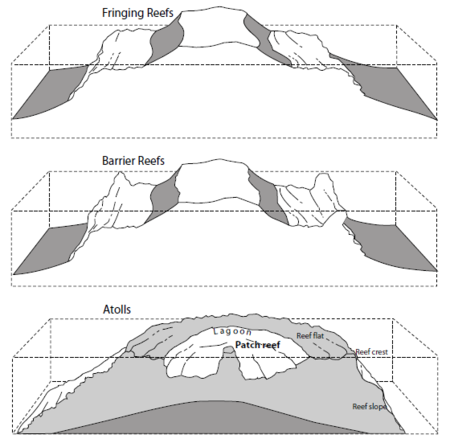 Coral reef types including atoll, fringing, barrier and patch reefs. Credit: NOAA Coral reef types including atoll, fringing, barrier and patch reefs. Credit: NOAA
|
How corals are exposed to oil bears directly on how serious the impact will be. There are three primary modes of exposure for [[coral reef]s] in oil spills. In some areas (especially the Indo-Pacific), direct contact is possible when surface oil is deposited on intertidal corals. Presuming that some portion of spilled oil will enter the water column either as a dissolved fraction or suspended in small droplets, this potential exposure pathway must be considered in most cases. Subsurface oil is a possibility in some spills, particularly if the spilled product is heavy, with a density approaching or exceeding that of seawater, and if conditions permit oil to mix with sediment material to further increase density.
Evaluation of risk based on exposure pathway is a complex calculus that is highly spill-dependent. Relevant questions that feed into the determination are linked to the considerations above and include:
- Are corals in the affected area intertidal?
- At what depths do the subtidal corals occur?
- Does this spilled oil have a component of lighter, more water-soluble compounds?
- Will sea conditions mix oil on the surface into the water column?
- Is there a heavier component to the oil that raises the possibility of a density increase through weathering and association with sediment that could sink the oil to the bottom?
- Will residual oil on adjacent shorelines (e.g., mangrove forests) provide a source of chronic oil exposure?
Areas with intertidal corals could be considered at greatest risk in a spill because of the increased potential for direct contact with a relatively fresh oil slick. Regardless of differences in susceptibility by species or physical form, direct oil contact is most likely to result in acute impact because in this kind of exposure scenario the oil is fresher, with a greater proportion of more toxic lighter aromatic hydrocarbons.
Water column exposure
Coral exposure via the water column can be a serious route under some circumstances. Because much of the constituent material in oil has a relatively low solubility in water, in general coral may be protected from exposure by overlying waters. However, if rough seas and a lighter, more soluble product are involved, subtidal corals may experience harmful exposure when oil mixes into the water column. The absolute levels of exposure would be expected to be much lower than those encountered by direct contact with intertidal slicks, since only a small fraction of the total oil can mix into the water column either in solution or physically suspended. However, the components of the oil mix most likely to enter the water column are those generally considered to be most acutely toxic. [[Coral]s] may therefore be exposed to “clouds” of naturally dispersed oil driven into the water column under turbulent conditions, with impacts dependent on exposure concentrations and length of exposure.
Where significant amounts of oil remain on adjacent shorelines after termination of cleanup efforts, such as in mangrove forests (Oil spills in mangroves), where inaccessible oil is left for natural removal, [[coral reef]s] may be affected by chronic oil exposure. There could also be episodic releases of higher amounts of oil during high-energy events. This process was one factor in the long-term effects of the 1986 Bahía Las Minas crude oil spill in Panama.
Heavy fuel oil exposure
Heavier fuel oils contain fewer of the light fractions identified with acute toxicity than do refined and crude oils (although these bunker type oils are sometimes “cut” with lighter materials to facilitate loading and transfer). If they remain on the water surface, spills of heavier fuel oils are less of a concern from a reef perspective, but more of a concern for protection of other habitats like mangrove forests (Oil spills in mangroves) where they can strand and persist for long periods of time, indirectly affecting [[coral reef]s] by chronic exposures as the oil is removed by natural processes. However, the heavy oils can also weather or mix with sediment material and increase in density to the point where they may actually sink—which provides a direct route of exposure to subtidal corals. Although acute toxicity characteristics of heavy fuel oils may be lower, the potential for significant physical effects from smothering is greatly increased.
Laboratory studies
Concentrations and exposure
Although many laboratory studies of oil toxicity to coral can be found in the literature, interpreting results from a spill response perspective is complicated by the experimental methods used. Many laboratory studies on the effects of oil on corals have limited applicability to real-life oil spill scenarios because of the way corals were exposed during the experiments, or how oil exposure was quantified. Many early studies on oil toxicity to coral relied on severe, direct exposure methods that were difficult to extrapolate to actual spill conditions. In addition, few studies actually quantified the exposure concentrations to corals, relying instead on a calculated, or nominal, value derived simply from the amount of oil mixed with a volume of water. Because only a fraction of the oil mixes directly into the water, the true toxicity levels can be assumed to be much lower than reported. This makes it difficult to compare studies or extrapolate data to real-life conditions.
During actual oil spills, oil concentrations do not remain constant, but vary over time. Oil is most concentrated at the very beginning of a spill when the product is consolidated in one location and relatively unweathered. As the spill spreads laterally and weathering processes begin, oil concentrations rapidly decline. These changing exposure levels can be simulated in experiments by reducing oil levels after a specified amount of time. Studies focusing on dispersed oil impacts use pulse exposures with flow-through systems, in which concentrations dissipate with time. When trying to estimate real-life exposures, it is important to carefully evaluate the methods used when applying data from laboratory studies.
Field studies
Field studies offer the best opportunity to understand the effects of oil spills under realistic conditions, but are uncommon in a coral reef habitat. One of the best examples is the 1986 Bahía Las Minas crude oil spill in Panama. This extensive series of studies documented both short-term mortality to corals and long-term, sublethal impacts to reproduction and growth lasting five years or longer. Guzmán et al. compared cover of common coral species at six reefs before 1985 and three months after the oil spill at Bahía Las Minas. At one heavily oiled reef, total coral cover decreased by 76 percent in the 0.5–3 m depth range and by 56 percent in the >3–6 m range. Cover decreased less at moderately oiled reefs and either increased or did not change at the unoiled reference reefs. The branching species Acropora palmata nearly disappeared at the heavily oiled site, but increased by 38 percent at the unoiled reefs. Coral colony size and diversity also decreased significantly with increased oiling. (See case studies for more detail.)
The 1984 TROPICS effort, sponsored by the American Petroleum Institute, was the most carefully designed and monitored attempt to perform a large-scale field experiment with corals and oil. Intended to provide a degree of realism within a more controlled setting than an actual spill, TROPICS examined short- and long-term effects of oil and dispersed oil to mangroves, seagrass, and coral reefs. Of these habitat types, coral reefs were least affected by exposure to oil alone, showing minimal short-term (0–20 months) and no long-term (10 years) effect to corals in an intentionally oiled zone. Mangroves were the most severely impacted, even 10 years after oiling.
Acute effects
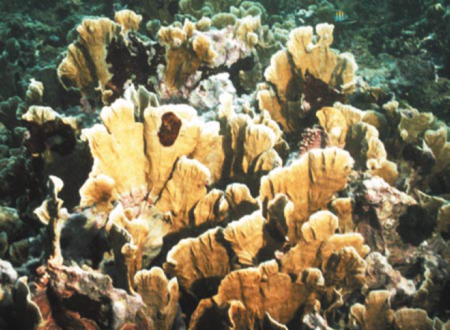 Close-up of bleached fire coral after oiling during the Bahia Las Minas spill in Panama. Credit: Arcadio Rodaniche; NOAA Close-up of bleached fire coral after oiling during the Bahia Las Minas spill in Panama. Credit: Arcadio Rodaniche; NOAA
|
A review of laboratory and field studies on acute effects of oil to corals can be confusing, since different studies appear to show contradictory results. Widespread coral mortalities following actual spills have been reported only infrequently, even when associated reef-dwelling organisms have perished. It may be that acute toxicity is not the best indicator of oil impact, and that adverse effects to the coral would be manifested over the longer term.
Oil exposure can kill coral, however, on varying time frames. Early studies of acute oil toxicity to coral used severe exposure conditions, such as directly coating coral with oil or submerging coral in marine diesel for 30 minutes. It is surprising that any of the test corals survived at all. Sometimes, a colony was not killed outright after a “dunking” in pure product, but later showed a steady decline in condition over a long period (>100 days) before dying.
A 1990 study by Harrison, using methods more comparable to spill conditions, found that low-level exposures almost completely disintegrated coral tissues after 48 hours. While they had selected a coral species known for its sensitivity to stress (A. formosa), these results suggest that longer exposure (4–48 hrs) to low concentrations of oil may be more toxic than shorter exposures at higher concentrations.
Recent studies have found enhanced phototoxicity from short-term and very low exposures to fluoranthene (a polynuclear aromatic hydrocarbon in oil) under outdoor light conditions (thus including ultraviolet radiation (Electromagnetic radiation) during the day) with the coral Porites. Interestingly, the upper sides of the coral fragments exposed to outdoor light exhibited bleaching and mortality within 3 to 6 days, whereas the under sides of each sample was normal. The calculated lethal concentration 50 (LC50) for the upper sides was an order of magnitude lower (14 times more toxic) than the lower sides of the corals. Also, replicate exposures under laboratory light conditions resulted in significantly less severe effects. Because corals grow in shallow, clear water with good light penetration, photoenhanced toxicity is likely to a significant mechanism, making corals much more sensitive to oil impacts than previously understood based on laboratory studies.
Differences in tolerance by coral species may be an important consideration but physical form may be more significant. Branching corals appear to be among the most susceptible whereas massive corals are more tolerant of oil exposure in laboratory studies. Bahía Las Minas field investigations noted that nearly all branching corals were killed in oiled reef areas. Thus, researchers could conduct longer-term studies only on massive species of coral.
The old notion that [[coral reef]s] do not suffer acute toxicity effects from oil floating over them is probably incorrect. Certainly, direct coating increases the severity of impact, but high oil concentrations in the water columns during a spill (Oil spill) may also kill some species.
Chronic effects
Chronic effects of oil exposure have been consistently noted in corals and, ultimately, can kill the entire colony. Chronic impacts include histological, biochemical, behavioral, reproductive, and developmental effects (see Table 2). Field studies of chronically polluted areas and manipulative studies in which corals are artificially exposed to oil show that some coral species tolerate oil better than other species. In contrast to acute toxicitystudies, nearly all researchers studying chronic effects have documented sublethal changes in exposed corals. Advances in technology now allow the detection of effects at cellular and genetic levels.
Sublethal oil exposure affects many normal biological functions, including reproduction and recruitment, which may have the greatest potential to adversely impact coral survival. A host of studies show that oil reduces coral fertility, decreases reproductive success, and inhibits early life stage development. A spill occurring at just the wrong time in a given area, at the peak of reproductive activity, could cause immediate and long-lasting harm to the communities of corals themselves. For example, several species of the coral Montastrea in Florida spawn during August and September. This would be a time when these communities would be at greater risk for reproductive impacts (see Table 1).
Oil also impairs two fundamental bioenergetic components for the entire coral reef community: primary production by the zooxanthellae symbionts in coral, and energy transfer via coral mucus. While some studies indicate that these effects are transient and that corals can recover from them in the absence of oil, circumstances of individual spills, including stress from other sources such as increased water temperature, will dictate whether these would be of concern to responders and resource managers.
Bioaccumulation
Oil quickly and readily bioaccumulates in coral tissues and is slow to depurate. This may be linked to the high lipid content of the tissues. Uptake into the symbiotic zooxanthellae also occurs. Researchers have found that petroleum hydrocarbons are deposited into the calcareous exoskeleton of corals, which introduces the possibility of using coral skeletons as historical records of hydrocarbon contamination in an area. Bahía Las Minas field studies indicated that corals took up [[hydrocarbon]s] from the water column, as opposed to sediments. Studies of cores up to 42 cm in length collected from the Arabian Gulf in 2003 detected petroleum biomarkers in several coral annual bands related to major pollution events in the region; however, the oil remaining in these cores had been altered over time such that the biomarker ratios in the oil residues differed from Gulf crude oils.
Associated reef organisms
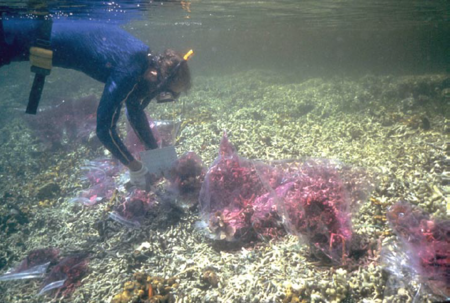 Diver studying coral growth as part of TROPICS study. Creidt: Research Planning Inc.; NOAA Diver studying coral growth as part of TROPICS study. Creidt: Research Planning Inc.; NOAA
|
In addition to corals themselves, oil may also adversely affect the associated fish, invertebrates, and plants in the coral reef community. Turtles (Sea turtles and the Deepwater Horizon oil spill) and marine mammals (Deepwater Horizon Oil Spill and Marine Mammals) may be seasonal inhabitants of the reef, and may be susceptible to direct oil exposure since they must surface regularly to breathe. Broad generalizations on oil toxicity are not very helpful for such a diverse group of species, life histories, and life stages. Though the scientific literature on oil toxicity to coral reef fish is limited, one can assume that they would show similar ranges in sensitivity to oil as would fish from temperate areas. Likewise, toxicity information on invertebrate groups could be generally inferred from data collected on related organisms from other habitats. Fish in open waters are thought to be able to avoid oil, although fish kills have been documented at several spills in shallow coral reef habitats (see the Morris J. Berman and Wake Island case studies). Since many coral reef fish have small home ranges and are residents of the reef, it follows that they would be at higher risk from oil exposure than non-resident, more widely ranging fish.
Some groups of invertebrates are known to be very sensitive to oil, including many crustaceans. As with coral reef fish, there are a number of documented incidents where invertebrates were killed after an oil spill. Some invertebrates, such as bivalves and snails, may not be acutely impacted by oil, but may accumulate oil components such as [[polynuclear aromatic hydrocarbon]s] (PAH) in their tissues. Species sensitivity varies greatly. Generally, early life stages are more sensitive than adult organisms, though there are exceptions. Consulting local experts and the broader toxicity literature is in order to assess oil toxicity to specific organisms in the reef community.
Also of concern are concentrations of fish and invertebrate larvae, which often are found within the upper water column where they may come in contact with oil products. Marine larval organisms may be more susceptible to oil toxicity given their surface-to-volume ratio and limited ability to steer clear of a spill. Larvae and other plankton serve as major food sources for a variety of coral reef organisms (including corals themselves). Larvae thus may serve as a mechanism for ingestion of oil products by reef organisms that otherwise would not come in contact with surface spills.
Response Methods For Coral Reef Areas
Key points
- Vessel accidents can hurt [[coral reef]s] as a result of spilled oil, groundings and other physical impacts, anchor damage, and release of ballast water or hazardous materials.
- All potential response options should be evaluated to determine whether the ultimate benefits from the response action outweigh the costs (or impacts) of the action.
- Remote locations, lack of response equipment, and waste disposal issues limit options for spill response in some coral regions.
- Mechanical cleanup and salvage efforts should avoid causing additional impacts to coral.
- In-situ burning can remove large amounts of oil rapidly, removing up to 90% or more of the oil.
- Dispersants are chemicals that break up of oil slicks by enhancing formation of small oil droplets that more readily disperse into the water column.
- In-situ burning and dispersing oil at sea can help reduce shoreline impacts and mortality of birds and other wildlife.
- Deciding whether or not to use dispersants involves difficult trade-off considerations.
The goal of spill response in coral areas is the same as in any other habitat—to minimize damages caused by the accident and any associated spillage. All potential response options should be evaluated to determine whether the ultimate benefits from the response action outweigh the costs (or impacts) of the action. Choosing response methods carefully, with an understanding of the sensitivities of the reef environment, will minimize any additional impacts incurred from the cleanup.
Variables such as location, weather, and availability of equipment for salvage, lightering, or cleanup will determine which options can be considered during a response in [[coral reef]s]. In the best-case scenario, modern response equipment will be available and salvage or lightering may be able to prevent any oil from spilling. Contingency plans may already be in place and specific response techniques can be evaluated and prepared, even if they turn out to be unnecessary. At the other end of the spectrum, response may be constrained by a remote site where equipment such as booms, skimmers, and sorbents may not be readily available. It may take long periods of time for salvage vessels to reach the scene and attempt to pull a damaged vessel off a reef (see Rose Atoll case study). Even when containment and collection of spilled oil is feasible, storage and disposal of collected waste products may limit cleanup operations.
General response considerations
In addition to toxic impacts from spilled oil, vessel accidents can hurt [[coral reef]s] in other ways, including groundings and other physical impacts, anchor damage, and release of ballast water or hazardous materials (Figure 1).
Physical impacts
Vessel traffic, anchor deployment, dragging lines, and physical contact by response workers can detrimentally impact coral reefs and associated habitats. Responders working near coral reefs should take care to avoid physical damage to coral, especially in shallow waters. Using floating lines, especially for salvage, but also for boom deployment and other operations, prevents damage to coral structures from dragging heavy lines over the reef itself. Response methods such as skimming (Skimmers) and placement of certain types of booms will need to be limited to deeper waters (greater than 3 meters) to avoid direct physical impacts to coral. In areas where coral is exposed at low tides, workers should avoid walking on reefs.
Ship groundings frequently damage reefs, and are discussed in more detail in the next section. Physical damage from a ship grounding may be the main impact to coral, especially when the ship is successfully refloated or lightered without spillage. Removal of a grounded vessel can add to the detrimental impact on the reef, especially if new channels have to be opened or constructed to remove the vessel (see the Rose Atoll case study). Even small pieces of debris can continue to damage the reef habitat; in some cases, dissolution of iron as the debris corrodes can have long-term impact (again, see the Rose Atoll case study).
Ballast water
To lighten and remove a grounded vessel from a coral reef, ballast water may be discharged. Ballast water may contain spores, eggs, larvae, or other life stages of marine life not indigenous to the reef ecosystem at the wreck site and, thus, may introduce these non-native organisms into areas where they can significantly alter the existing community structure. Response options can include treatment of ballast water before discharge with ozone, chlorine (Public Health Statement for Chlorine), or heat.
Hazardous cargo
Stricken or stranded vessels may release hazardous cargoes into a coral reef area. These can include many substances that are bulk-transported aboard ships: bulk organic (petro) chemicals, pesticides or herbicides, ores (such as copper), bulk acids and bases (such as sulfuric acid or caustic soda), and cement (as at the M/V. S. Zakariadze in Puerto Rico). Other items that have spilled include ammonia used in refrigeration of catch on fishing vessels, shipping containers, fishing gear (longlines, traps, or set nets), and decomposing animal matter such as bait or fish. Response options for these situations should be developed on a case-by-case basis.
Multiple aspects of an incident can require simultaneous attention. For example, the bulk carrier Igloo Moon stranded on a coral reef near Miami, damaging the coral reef. It was also at risk of spilling its cargo (butadiene), oil (bunker and diesel fuel), and potentially contaminated ballast water. The response sequence resembled a medical triage, in which activities were organized to maximize risk reduction. The coral reef was injured by the initial impact and subsequent vessel extraction, but presumably a much larger and longer-lasting disaster was prevented by careful treatment and discharge of the carrier’s ballast water and cargo, and fuel lightering.
Booming and skimming
Advantages/disadvantages
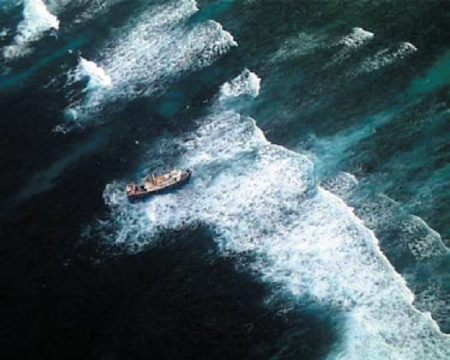 Shipwreck of the F/V Swordsman 1 aground on a coral reef at Pearl and Hermes Atoll, in the Western Hawaiian archipelago, June 2000. Credit: USFWS Shipwreck of the F/V Swordsman 1 aground on a coral reef at Pearl and Hermes Atoll, in the Western Hawaiian archipelago, June 2000. Credit: USFWS
|
Physical containment and collection of spilled oil on water using booms and skimmers is the primary cleanup method used at most spills. High current speeds, heavy wave action, or shallow water may limit the effectiveness of either booms or skimmers and necessitate consideration of alternative cleanup strategies. Skimming operations will most likely be conducted outside the reef in deeper waters to prevent oil from coming over the reef crest. It may be difficult to anchor collection booms on the reef slope because of great depth.
Booms should be anchored in a way that does not damage coral, and tended regularly to maintain effective positioning and avoid damaging shallow coral. Sorbent booms can be deployed to catch oil leaching from shorelines, but must be tended and changed frequently so they do not become a source of oiling themselves. In some circumstances, oil can be collected via vacuum pumps, if it is concentrated nearshore on water, provided there is appropriate access for the mechanical equipment.
Once the oil is collected, adequate short-term storage is necessary, as well as a disposal plan for the waste oil and other waste products. Disposal issues can be significant, especially in remote areas, and lack of available collection facilities can limit skimming (Skimmers) operations. At the Morris J. Berman barge oil spill in Puerto Rico, the pools of a large swim stadium were put into service for temporary waste oil collection and water separation.
Skimmer and boom guidelines
- Limit collection and skimming (Skimmers) operations to water deeper than 3 meters.
- Tend booms regularly so they do not harm shallow reefs.
- Do not damage coral when anchoring booms.
- Route boat traffic away from shallow reefs and seagrass beds to avoid propeller damage and increased sedimentation.
In-situ burning
In-situ burning is a response technique in which spilled oil is burned in place. It has been adapted and used in settings as varied as the open ocean and in marsh areas.
Advantages/disadvantages
In-situ burning can remove large amounts of oil relatively rapidly. Estimated removal efficiencies of 90 percent and above (of contained oil) far exceed those for mechanical or chemical response methods. Burning requires less equipment, logistical support, fewer personnel, and produces less waste material than other cleanup techniques. In remote locations where many coral reef spills occur, these offer significant advantages logistically and environmentally. As long as oil has not emulsified (if the water content is greater than 25 percent, it will not burn) the response window for burning on water can last several days.
In order to sustain burning oil, the slick must be at least ~2–3 mm thick. Either the spilled oil must be present in that thickness in the slick or natural collection area, or specialized (and expensive) burn boom can be deployed to collect and retain the oil for burning. In-situ burning is less effective if winds are greater than 20 knots and seas are greater than 2–3 feet.
In-situ burning produces large amounts of highly visible smoke and other combustion by-products, which can be a significant deterrent to its use, especially in areas near human populations. The smoke plume presents both a human and animal (e.g., marine mammals) health risk, primarily from fine particulate material that may aggravate respiratory conditions. The smoke is also a problem of perception: a massive black plume appears formidable and menacing. However, the remoteness of many potentially affected coral reef areas may minimize this concern. Special Monitoring of Alternate Response Techonolgies (SMART) air monitoring protocols, developed by NOAA (National Oceanic and Atmospheric Administration (NOAA), United States), the U.S. Environmental Protection Agency, the U.S. Coast Guard, and the Agency for Toxic Substances and Disease Registry, can be deployed when burning is conducted near population centers to monitor particulate levels and provide real-time feedback to the responders. This feedback helps responders determine safe boundaries beyond which smoke levels do not pose health risks to people.
Burning in coral reef areas
To our knowledge, there have been no intentional large-scale in-situ burns in coral reef habitats. During World War II, many ships and aircraft that were attacked near corals released oil and were set ablaze, particularly in the Indo-Pacific region. For understandable reasons, the environmental impacts of these events were not documented. During the 1968 Witwater spill in Panama, small patches of heavy oil apparently were burned as a shoreline oil removal technique, but this was a limited and small-scale application.
Environmental impacts
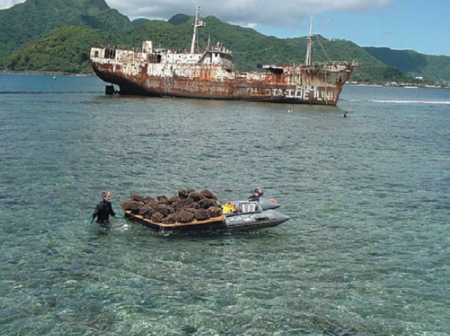 Coral transplanting as part of restoration activities in Pago Pago, American Samoa, 1999. Credit: NOAA OR&R Coral transplanting as part of restoration activities in Pago Pago, American Samoa, 1999. Credit: NOAA OR&R
|
There are no studies of in-situ burning in coral regions. Burning is a still a relatively rarely used spill response method, and studies on its environmental effects and toxicology are limited. The Newfoundland Offshore Burn Experiment (NOBE) provides much of our current information on burning oil at sea. Crude oil was intentionally released, ignited, allowed to burn, and extensively studied, including water-column toxicity to marine organisms, and associated physical effects from the burn.
The results from NOBE experiments and other studies indicate that crude oil burn residue has a low inherent toxicity to test organisms, and incurred no additional toxicity compared to unburned oil. Extrapolation of these results to tropical areas and coral reefs should be done cautiously, however.
In some instances the physical characteristics of burned oil residue could be a concern, especially if the density is significantly increased from that of the source oil. There have been some observations from both controlled burn experiments and from actual ship fires that burn residue can sink under specific circumstances. Recent studies have predicted that residues from about half of international crude oils would tend to sink in seawater, but only after cooling. It may be possible to collect the burn residues while they are still hot and buoyant. Nets deployed under the burn area might allow capture of sinking residues. Based on the previously mentioned studies, the inherent toxicity of the material is believed to be low; but the physical impacts of contact (such as fouling or smothering) may be a concern. Given the alternative of much greater volumes of unburned oil impacting nearby resources, the tradeoff offered by burning seems reasonable; as always, however, the risk assessment of different response options must take place on a case-by-case basis.
Water temperatures under a burning slick can reach near boiling in the top few millimeters in a static situation. However, water only a few centimeters below the slick remains unaffected. If a fire boom containing a burning oil slick is being towed or if underlying water is moving, then there is no appreciable rise in water temperature.
In-situ burning guidelines
- Burning may be effective on many oil types, except emulsified oil (water content of greater than 25%). Burning medium to heavy oils may produce residue that sinks.
- Oil must be 2–3 mm thick to sustain a burn—it can be collected in natural containment areas, or in special fire boom that can be towed on water.
- Weather conditions are conducive for burning when winds are less than 20 knots and seas are less than 2–3 feet.
- SMART air monitoring protocols can help delimit areas where smoke plumes do not present a health risk for people.
Dispersants
Dispersants are chemicals containing surfactants, like those in soaps and detergents, which have both a water-soluble and an oil-soluble component. When applied to oil slicks, they reduce the surface tension of the oil and promote the formation small oil droplets that “disperse” throughout the water column. Dispersants are sprayed directly on floating oil as a fine mist, either from aircraft or boats. Oil also disperses naturally, especially lighter fuels and oils spilled in areas with heavy Wave action; however, the droplets are generally larger and can recoalesce and re-float.
Dispersants have been used on a number of tropical oil spills, but the follow-up data are scarce, especially on potential impacts to coral reefs. Regional contingency plans that pre-approve the use of dispersants generally place greater restrictions on their use in nearshore waters. Currently, some regions are considering conditions under which dispersants may be safely and effectively used close to shore. This involves understanding the toxicity and fate of dispersed oil and balancing possible tradeoffs when oil may impact sensitive shorelines such as mangrove (Mangrove ecology) forests.
Advantages/disadvantages
Dispersing oil may reduce the damaging effects of surface slicks on birds, sea turtles, and marine mammals and help prevent oil from stranding on tourist beaches or impacting sensitive shoreline habitats such as mangrove (Mangrove ecology)s, [[marsh]es], or enclosed lagoons. Dispersants treat large slicks quickly, reducing the formation of emulsions, and accelerate the biodegradation of oil in the water column. Dispersants are an important cleanup tool, and offer a response method that can be deployed during weather conditions that preclude mechanical recovery methods. Dispersion is the primary response option in many countries and a secondary option in several others. Many tropical islands, atolls, and reefs are too remote to deploy mechanical protection and cleanup methods, but dispersant use may still be an option if pre-planning efforts have stockpiled dispersants in readily available locations.
Under the proper conditions, lighter fuel oils to medium crude oil can be easily dispersed, but heavier bunker oils are much more difficult to disperse. Weathering increases oil viscosity and may cause formation of water-in-oil emulsions, which are less amenable to dispersion. A moderate amount of turbulence is needed to mix dispersed oil into the surface waters. Vertical mixing and diffusion then dilute and disperse the oil further into the water column. Test applications of dispersants can be used to determine the viability of response-scale applications at a given spill.
Dispersant use in coral reef areas
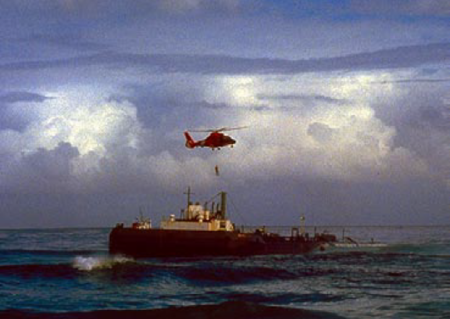 A helicopter brings response personnel to the grounded barge Morris J. Berman off San Juan, Puerto Rico, 1994. Credit: NOAA OR&R A helicopter brings response personnel to the grounded barge Morris J. Berman off San Juan, Puerto Rico, 1994. Credit: NOAA OR&R
|
During the past three decades, dispersants were among the countermeasures used to combat several spills impacting tropical coasts. However, we have little documentation of these events, especially the benefits or impacts to coral reefs and adjacent habitats (see case studies for Ocean Eagle, Bahía las Minas, and field studies). The fate of dispersed oil has been studied in several Northern Hemisphere offshore and nearshore locations, but there have been very few studies in tropical areas near coral reefs. Field and laboratory research studies provide the following picture.
A common misconception is that dispersed oil sinks to the bottom. In fact, wave action and currents rapidly dilute and disperse the plume of dispersed oil and transport it away from the treated site. The subsurface plume may move in a different direction and speed than the untreated surface slick. Within several hours the plume grows and oil concentrations greatly decrease. Within a day or two, dilution, spreading, and transport reduce the concentration of dispersed oil by a factor of 100, 1,000, or even 10,000.
Dispersed oil degrades via natural processes, including biodegradation. Laboratory studies indicate that, in cooler water systems, dispersed oil biodegrades much more quickly than undispersed oil (on time frames of a few days to several weeks). Although no comparable work has been done in tropical settings, it is likely that dispersed oil degrades much faster than in temperate areas because of warmer temperatures.
Given the right oceanographic conditions, dispersant use may be appropriate near submerged coral reefs (i.e., where water depth increases quickly, and subsurface currents are likely to carry dispersed oil away from the reef). NOAA has modeled such situations for potential spills, when dispersants were considered as a response tool near a coral reef. Usually, these determinations are made after considering the potential shoreline impacts and evaluating local weather and oceanographic conditions at the time of the spill.
In the Caribbean and some parts of the Pacific, shorelines adjacent to coral reefs contain mangrove (Mangrove ecology) forests, which are highly sensitive to oil. At many tropical oil spills, the most severe impact is to mangroves, sea turtle nesting areas, or other sensitive shoreline habitats. Recovery of severely impacted mangrove forests takes decades and often has associated impacts, including shoreline erosion, decimated marine life nursery areas, or chronic leaching of oil from contaminated sediments (see Bahía las Minas case study). When conditions are appropriate to minimize impacts to coral, using dispersants or in-situ burning on floating oil can be an effective and environmentally advantageous cleanup strategy that reduces long-term impacts.
Toxicity of dispersed oil
Toxicity studies screen dispersant products and provide data for planning dispersant use during spills. In tropical areas, there is continued reluctance towards using dispersants nearshore (closer than 3 miles) because of concerns about possible detrimental impacts to coral and associated reef inhabitants. In the previous section, we discuss methods used for laboratory studies of oil toxicity and how these impact the resulting data. As with coral toxicity studies on oil alone, laboratory protocols should be carefully evaluated before applying toxicity lab results to real-life dispersed oil scenarios. As discussed earlier, most laboratory toxicity tests have been conducted under artifical light; studies have shown that oil toxicity under natural light (that includes ultraviolet radiation) can be at least an order of magnitude higher. Table 3 summarizes relatively recent studies on toxicity of chemically dispersed oil.
Field studies provide more realistic guidance about dispersed oil toxicity in larger systems. Table 4 summarizes field studies from Bermuda, the Arabian Gulf, and Panama on impacts to coral from chemically dispersed oil. Coral follows the pattern of most other organisms: its sensitivity to dispersed oil depends on the dose (the concentration and the length of exposure). Very high dispersed oil concentrations and long exposures can kill coral, whereas lower doses and short-term exposure show few, if any, impacts, many of which are reversible. Thus, dispersants and dispersed oil may be less damaging in real field conditions than had been suggested by older laboratory toxicity tests. These results highlight the importance of evaluating toxicity in the context of realistic exposures, which can be estimated from oceanographic models.
Dispersants guidelines
- Dispersants are applied using spraying systems, mostly aerial or from vessels, at a specific treatment rate, (e.g., 5 gallons per acre of oil, or dispersant:oil ratio of 1:20). Multiple applications may be needed over several days.
- The window of opportunity for effective use of dispersants is small: it depends on the oil type, and narrows with oil weathering and increases in viscosity and emulsification.
- Dispersant use is not likely to be 100% effective and thus will not eliminate the need for other response methods, or the effects of the undispersed oil.
- Available dispersants are much less toxic than older formulations; most toxic impacts are from the oil itself.
- Dispersant trade-offs center on potential impacts to water-column and shallow benthic organisms versus impacts to birds, mammals, turtles, and shoreline resources (such as mangroves).
- Recommendations from the National Research Council (ASTM 1987) on dispersant use around coral reefs:
- Whenever an oil spill occurs in the general vicinity of a coral reef, dispersant use should be considered to prevent floating oil from reaching the reef.
- Dispersant-use decisions to treat oil already over a reef should take into account the type of oil and location of the reef.
- Coral reefs with emergent portions are high-priority habitats for protection during oil spills.
- The use of dispersants over shallow submergent reefs is generally not recommended, but the potential impacts to the reef should be weighed against impacts that might occur from allowing the oil to come ashore.
- Dispersant use should be considered to treat oil over reefs in water depths greater than 10 m if the alternative is to allow the oil to impact other sensitive habitats on shore.
- Chemical Dispersion is not recommended to treat oil already in reef habitats having low-water exchange rates (e.g., lagoons and atolls) if mechanical cleanup methods are possible.
Coral Reef Restoration
Key points
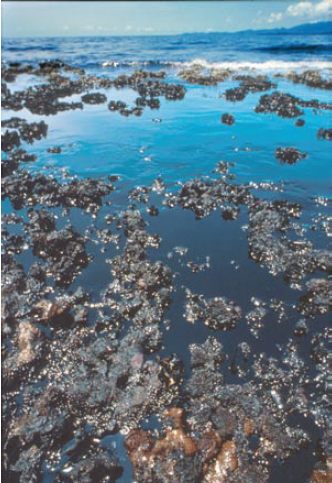 Oiled coral exposed at low tide, Bahia Las Minas, Panama. Credit: Carl Hansen; NOAA Oiled coral exposed at low tide, Bahia Las Minas, Panama. Credit: Carl Hansen; NOAA
|
- Ship groundings on coral reefs physically damage the reef framework, increasing erosion and reef degradation.
- Reef crust and loose rubble should be stabilized as soon as possible after they are physically damaged.
- Damaged coral reefs may take decades to centuries to fully recover.
- Coral transplanting can expedite coral recolonization of damaged areas, especially in protected areas.
- Massive corals survive transplanting better than branched corals, but are very slow-growing. Soft corals are difficult to transplant successfully.
- Physical surroundings affect how fast coral regrows.
- The recovered reef may be different from the original.
- Recovery is more likely after acute rather than chronic disturbances.
- Delaying restoration may significantly increase restoration costs, increase recovery time, and decrease likelihood of full recovery.
Most work to restore coral reefs to date has focused on restoring physical injuries caused by vessel groundings rather than injury resulting from oil or chemical exposure. Grounding impacts are, in many cases, the main injuries inflicted on coral reefs from “potential” spills or spills of small to moderate quantities of oil. The initial grounding itself and subsequent attempts to free the vessel may physically damage the reef framework and resident marine organisms. Direct grounding damage is often later exacerbated by associated mobile debris. Grounding of vessels of all types on reefs continues to be a significant source of injury to coral reefs around the world.
Accretive and destructive (or erosive) forces act continuously upon coral reefs in relative steady state. Damage to a coral reef framework opens the door for destructive forces to gain ground and degrade the reef. Once this reef framework, or “crust,” is breached, for example by the hull of a grounded vessel, ship propellers, anchors, or towlines, the unconsolidated material beneath the surface is exposed. The breached area, if not repaired, will expand over time, especially during storms or hurricanes. Furthermore, the exposed coral rubble can be mobilized during storms and cause collateral reef damage. Structural restoration of the damaged reef framework, including stabilizing loose rubble, is essential before either natural or enhanced recovery of the live reef community can occur. Reef framework restoration should be conducted as soon as possible after a vessel grounding to minimize mortality of reef biota and risk of additional injury during storms. Delaying restoration may significantly increase restoration costs, increase recovery time, and decrease likelihood of full recovery.
Restoration through prevention
Even under the best restoration efforts, coral reefs, once injured, may take decades, if not centuries, to recover. In some cases, injured reefs may never recover. The best strategy is to prevent reef injury in the first place through effective vessel management. Designating “areas to be avoided” by large commercial vessels is one way to help maximize vessel safety and minimize physical and biological damage to reefs in areas such as National Marine Sanctuaries. However, large commercial vessels are a small component of a chronic problem. In the Florida Keys National Marine Sanctuary there are over 580 reported groundings a year, with 40-50% of these on coral and the rest on seagrass and hard-bottom habitats. A significant number of these incidents result in small spills of refrigerants, lube oils, and diesel fuels. Improved navigational technology and education for mariners can also help prevent vessel groundings. Part of the settlement with the Responsible Party for a container ship grounding in the Florida Keys included the installation of navigation buoys along the outer reef edge. It was estimated that if this system (installed in 1999) had been in place, it would have prevented 56% of the groundings that occurred along the Florida Keys reef system between 1984 and 1999. Nevertheless, it is likely that groundings, like oil spills, will continue. Consequently, restoring the physical and biological integrity of damaged coral reefs will continue to play an important role in the maintenance of healthy coral reef ecosystems.
Coral transplanting
Coral recruitment onto either intact reef framework or structurally restored reef framework may be limited due to scarcity of coral larvae or due to chronic anthropogenic disturbances and influences that inhibit successful settlement of larvae. In such cases, transplanting coral can help expedite coral recolonization of damaged reef areas.
Transplanted corals often survive and grow in low-energy areas, although damage and mortality from wave action is common in less protected locations. Staghorn corals and other branching corals of the genus Acropora show good survival and rapid growth after transplanting, but their branching growth form and small area of attachment seem to make them particularly vulnerable to damage from strong wave action. Thus, using staghorn corals for transplanting may be limited to more sheltered areas. Coral species with massive growth forms are more resilient to wave action but are very slow-growing, which may make them less suitable for transplanting where rapid recolonization is desired. Soft corals are more difficult than hard corals to relocate without injuring the delicate holdfast tissue, which often eventually kills the transplant.
If coral for transplanting is not available from the damaged area, such as coral broken off or mobilized from vessel groundings, extreme caution must be exercised to prevent injury to donor populations. In addition to transplanting, reattachment of broken or toppled corals using quick-setting lime cement or epoxies has been used to successfully restore some species of damaged corals, as described by Hudson and Goodwin (1997).
Coral reef recovery rates
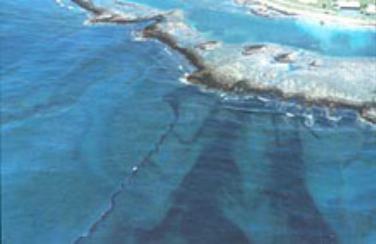 Oil sicks moving onto coral reefs of Galeta, Panama at low tide during the Bahia Las Minas refinery spill in April of 1986. Credit: NOAA Oil sicks moving onto coral reefs of Galeta, Panama at low tide during the Bahia Las Minas refinery spill in April of 1986. Credit: NOAA
|
Corals are long-lived and recover slowly from disturbances, whether these are natural, such as hurricanes (Hurricane), or human-caused, such as ship groundings or exposure to pollutants. How fast and how well a coral reef recovers depends on the extent and type of damage, the location, species affected, suitable habitat, and many other parameters. Severe and repeated impacts delay recovery, while ongoing pollution and other chronic stresses may postpone it indefinitely.
Recovery is commonly measured using percent coral cover, species diversity, mean colony height, and overall coral color and health. Disturbed areas are compared with nearby areas that have not been impacted, or with data collected from the same area before the disturbance. Coral on damaged reefs recover by regenerating from partially damaged colonies, by reestablishing broken coral fragments, and through settlement of coral larvae carried by ocean currents.
If corals are injured but not killed, survivors regrow as the primary recovery mechanism. If most of the coral is killed, recovery will depend almost entirely on recruitment and growth of propagules from elsewhere, which will be much slower. A physically damaged reef recovers more slowly, and may need restoration. For example, vessel groundings fragment coral skeletons, producing loose rubble and fine sediments that inhibit successful recolonization of hard corals. When destruction is localized and small-scale, coral reef communities usually recover in less than ten years, if major sectors of the community are left intact and the area involved is not already marginal for coral growth. Reefs damaged by major natural disasters may take up to 20 years or longer for full recovery of affected areas. Where destruction has been particularly severe, complete reef recovery may take several decades or perhaps over a century. Corals of the Great Barrier Reef devastated by Crown of Thorns starfish may require 20 to 40 years for full recovery if the bulk of hard coral cover has been lost. Recovery may be delayed indefinitely if starfish infestations recur or if reefs are subsequently impacted by other natural or human-induced disturbances.
Recovery may also be delayed if the exposed substrate is resettled by fleshy seaweeds instead of coral or coralline algae. The situation can be exacerbated further if the algae are alien species. Given the right environmental conditions, a seaweed may be able to gain a foothold at a grounding site and then spread outwards over previously unimpacted reef.
Recovery time depends on the type and intensity of the disturbance. From observing coral communities in the Great Barrier Reef over a 30-year period, Connell et al. (1997) found that coral assemblages usually recovered from acute disturbances, though rates were slower if disturbances altered the physical environment than if they simply killed or damaged corals. In contrast, corals did not recover from chronic disturbances of either natural or human origins, or from gradual declines. Thus, recovery was more likely if disturbances were acute rather than chronic, since recovery will be continually interrupted or set back by repeated, chronic disturbances.
When a coral ecosystem has completely collapsed or the reef environment has changed permanently, making conditions unsuitable for coral, there may be no significant recovery. In areas that are marginal for coral growth, disturbances may result in algae replacing coral completely. Where recovery does occur, the reef may differ from the original in species composition, biological assemblages, and reef building capacity.
Physical characteristics such as exposure can significantly influence the process and rate of recovery for impacted reefs. For example, areas decimated by lava flows in Hawai’i took about 20 years to recover in exposed areas and more than 50 years in sheltered areas. For reefs in Hawai’i and the Eastern Pacific, which are physically controlled coral communities, recovery rates are related to the degree of exposure to sea and swell. Exposed areas require less time for recovery since coral is naturally less abundant in exposed areas and less growth is required for a reef to completely recover to background conditions. Growth rates of some corals are higher in exposed areas, which may be related to differences in circulation or food supply. However, recovery patterns may be different in more biologically accommodated coral reef communities, such as those in the Caribbean and Red Sea.
In a review of coral reef recovery rate, Zengel and Hinkeldey (2000) made these key points:
- Early-successional coral communities generally recover in about 10-20 years or less following relatively small-scale or localized, acute disturbances that do not change the suitability of the site for coral recruitment, growth, and survival.
- Coral communities that are more mature, in late-successional to climax stages, may require several decades to a century or more to recover, especially if long-lived, large-sized, persistent species are lost.
- Branching Acropora stands, particularly those in the Caribbean and Florida, can show variable recovery times, from relatively fast to much longer, depending on the nature and extent of the disturbance.
- There is some evidence that coral communities in the Western Atlantic region may be less likely to recover, or may recover more slowly, than corals in the Indo-Pacific region.
- Coral communities at greater depth may recover more slowly than those in shallow waters.
- Severe disturbances that kill or remove all or most corals, or that cover large spatial areas result in longer recovery times.
- Severe disturbances that alter the physical environment or landscape result in substantially longer recovery times.
- Recovery is more likely and more rapid following acute (short-term) vs. chronic (long-term) disturbances.
- Recovery from an acute disturbance can be hindered by pre-existing or co-occurring chronic disturbance; likewise, several disturbances or “multiple stressors” can interact, limiting recovery.
- In some cases, disturbance can result in a “phase shift” to a macroalgae community, limiting or precluding coral recovery.
Recovery from oil exposure
Coral communities may recover more rapidly from oil exposure alone than from mechanical damage. Coral reefs exposed to crude oil and chemically dispersed crude oil in field experiments conducted in Panama showed recovery, with no significant differences between the exposed and control sites, after ten years. Short-term bioassays of corals exposed to oil have revealed temporary effects followed by recovery generally within one week.
Recovery of coral reefs after oil exposure, however, may depend partly on the recovery of associated communities that may be more seriously affected, such as mangrove (Mangrove ecology)s and seagrass beds. As described in the case study, the 1986 Bahía las Minas oil spill in Panama impacted mangrove and seagrass communities, as well as corals. Death and injury of these habitat-structuring organisms physically destroyed habitats. The secondary biological effects of erosion and redeposition of oily sediments included greatly increased levels of injuries and decreased growth and sexual reproduction for surviving subtidal reef corals in Bahía Las Minas compared to coral reefs outside the bay. The entire Bahía Las Minas ecosystem became more vulnerable to subsequent natural or anthropogenic disturbances. It has been estimated that recovery of the dominant reef-building corals may require at least a century or more to reach the size of many of the colonies killed by this spill.
Coral Case Studies
Introduction
By studying past oil spills in coral reef environments, we get a good idea of some of the complexities and variability of these types of incidents. We have searched for case studies of oil spills impacting coral reefs that were well documented both during the incident and response, and also were re-visited after the spill to determine long-term outcomes. Unfortunately, many incidents are poorly documented, especially those dating back several decades. We describe several case studies representing oil spills from the Pacific, Caribbean, and Arabian regions. Some events caused devastating, long-lasting impacts, while others appeared to have caused little long-term impact to corals. Some spills, such as the Ocean Eagle and Morris J. Berman, did not impact coral because the oil did not reach areas rich in coral. However, these incidents illustrate many of the other response limitations that may be present on tropical island incidents, such as limited availability of salvage and response equipment and limited storage capacity for collected oil. The Rose Atoll incident illustrates an unfortunate but not uncommon type of spill, especially in the Pacific—a freighter or fishing vessel runs aground in bad weather on a remote atoll. Response options are almost nonexistent, and salvage vessels must travel for several days to weeks to reach the site. The ship often breaks up before the salvor can reach the scene, spilling cargo and fuel and causing repeated physical damage as wind and waves toss the wreck about on sensitive coral structures.
For several spills that were not well documented, and where limited follow-up research was conducted after the spill, we often do not know whether corals were impacted or for how long (e.g., R. C. Stoner and Zoe Colocotronis). At the time, these response efforts and associated studies focused on oiled beaches and shorelines that represented a valuable economic resource, while paying less attention to offshore, underwater habitats. Our most extensively documented case study is that of Bahía las Minas, Panama where several biological habitats were studied intensively, and followed for many years after the spill. Bahía las Minas provides an excellent example of the tradeoffs that are encountered in many tropical environments between different nearshore habitats, such as mangrove (Mangrove ecology)s, and subtidal seagrass beds or coral reefs and how these respond differently to oil contamination.
We have included descriptions of two field experiments that, while not representing actual oil spills, do provide good information on oil spill impacts in a controlled, non-laboratory setting. Lastly, several restoration case studies give current examples of how reefs that have been physically damaged from ship groundings can be given a boost towards eventual recovery by the developing technologies of reef restoration.
Spill case studies
R. C. Stoner, Wake Island/September 1967
On September 6, 1967, the tanker R. C. Stoner grounded 200 meters southwest of the harbor entrance at Wake Island. Wake Island, in the North Pacific Ocean, consists of three islets forming an atoll enclosing a shallow lagoon. The tanker was fully loaded with over 6 million gallons of refined fuel oil, including 5.7 million gallons of aviation fuel; 168,000 gallons of diesel oil; and 138,600 gallons of Bunker C. There was an immediate release of fuel after the grounding, believed to be primarily aviation fuel. On the following day, a “considerable quantity” of Bunker C was also observed, and gasoline vapor odor was detected through September 8.
The heavy cargo load and rough seas hampered efforts to refloat the vessel, and on September 8 the stern of the ship broke off. An estimated 600,000 gallons of the mixed fuels covered the surface of a small boat harbor, up to 20 cm thick. The strong southwest winds concentrated the spilled oil in that harbor and along the southwestern coast of Wake Island.
Response
Oil recovered from the small boat harbor by pumps and skimmers was moved into pits near the shore and burned each evening; over 100,000 gallons were disposed of in this fashion. The oil was blocked from entering the central lagoon area of the Wake Island group by an earthen causeway.
Impacts
Large numbers of dead fish were stranded along the southwestern shoreline. The Federal Aviation Administration (FAA) cleared the area closest to the spill of dead fish. In addition to the massive fish kill (approximately 1,360 kg collected), dead turbine [sic] molluscs, sea urchins, and a few beach crabs were also reported. About 2.4 km of shoreline beyond the FAA-cleaned zone was also oil-contaminated; another 900 kg of dead fish were present but not removed. Other dead invertebrates included cowries, nudibranches, and grapsoid crabs.
In this assessment, corals in the area were mentioned only in passing and apparently were not surveyed either formally or informally for impact. Discussion of corals was completely in the context of the associated fish communities. Given the mixture and quantities of fuel spilled, and the massive mortalities manifested in fish and reef-associated invertebrates, there almost certainly was an impact to the coral animals themselves. Gooding did note that, on a survey conducted 11 days after the grounding (after a typhoon had passed through the area), the only remaining visible impact in the inner harbor was black oil impregnated in coral. He stated that only cursory observations were made on reef invertebrates and, given external challenges to impact assessment described in the account (typhoons, tropical storm, harassment by black-tipped sharks, skin irritation to divers from exposure to fuels in water), effects to coral was presumably not included in survey objectives.
Ocean Eagle spill, Puerto Rico / March 1968 and Morris J. Berman, Puerto Rico / January 1994
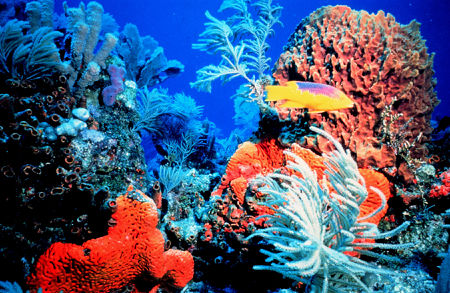 Spanish hogfish at reef. Credit: NOAA Spanish hogfish at reef. Credit: NOAA
|
These two spills are grouped together primarily because they had similar locations, along the northern shoreline of Puerto Rico; and both reported a lack of impacts to coral reefs. The two considerations are linked. The northern coast of Puerto Rico has many large hotels and recreational beaches, but few coral reef areas. The circumstances of the two spills were otherwise rather different. The Ocean Eagle grounded on March 3, 1968 in San Juan Harbor, after which it broke in two and spilled 83,400 bbl of Venezuelan light crude oil. The Morris J. Berman was a barge laden primarily with a No. 6 fuel oil that drifted ashore about 300 meters off Escambron Beach after its towing cable parted on January 7, 1994.
Response
At the Ocean Eagle, chemical treatments then called an “emulsifier” were spread on thick oil on the water surface. These treatments were described as effective, apparently functioning similarly to dispersants. The Berman barge was eventually pulled off its grounding site and scuttled in deeper waters offshore. Shoreline cleanup was extensive, and included manual cleanup and washing. Submerged oil mats were collected by divers.
Impacts
Impacts of concern, as noted above, were similar for both incidents. Nearly all of the large tourist hotels and beaches in San Juan are concentrated along the north-central shoreline of Puerto Rico, where much of the oil in both incidents came ashore. Although many of these recreational areas were heavily impacted, sensitive natural resources such as coral reefs and mangrove (Mangrove ecology)s that would be a major concern elsewhere in Puerto Rico are not found in abundance here. Widespread mortalities, primarily among fish and benthic invertebrates, were noted during both the Ocean Eagle and the Morris J. Berman spills; however, except for a small number of soft corals at the Berman grounding site, there is no mention of adverse effects to corals. This should not be construed as the absence for potential effect, but rather as a semi-fortuitous consequence of spill location and circumstance.
SS Witwater spill, Panama / December 1968
On December 13, 1968, the 35,000-barrel tanker SS Witwater broke apart on the Caribbean coast of Panama and released around 20,000 barrels of Bunker C and marine diesel oil. The spill occurred within three miles of the then-new Smithsonian Tropical Research Institute laboratory at Galeta Point.
Response
Response methods included pumping and in-situ burning of oil that collected in a small bay. Little documentation is available about how the burning was conducted, though it appears to have been without booms, and was considered successful in removing some oil and in limiting environmental impacts.
Environmental impacts
A follow-up study conducted two months after the spill found that coral reefs were the least affected of all the communities studied and no ill effects to corals (mainly Porites furcata, P. asteroides, Siderastrea radians, and Millepora complanata (a hydrocoral)) were observed. Since the reefs are subtidal, they had no direct contact with the oil, and a higher-than-normal low tide caused by high winds may have protected coral from impacts. The incident highlighted the dearth of baseline information on Caribbean intertidal reef flat communities. A substantial effort was invested by the Smithsonian lab to compile those data, which were then used to provide background information for experimental tests of effects of oil, reported in Birkeland et al. (1976).
Black and red mangrove (Mangrove ecology)s were more severely impacted, with visible sediment contamination, oil coating on roots and pneumatophores, and die-off of seedlings. Sandy shorelines had heavily oiled subsurface sediments, to depths of 30 cm.
Zoe Colocotronis / March 1973
On March 18, 1973 the tanker Zoe Colocotronis intentionally dumped 37,000 barrels of Venezuelan crude oil in order to lighter the vessel from the reef on which it grounded. Oil was carried ashore to beaches near Cabo Rojo in Bahía Sucia, Puerto Rico and into several areas containing mangrove forests.
Response
Response efforts included [[boom]ing], digging sumps, and pumping collected oil into tank trucks. The U.S. Coast Guard Atlantic Strike Team helped with beach cleanup.
Impacts
Oil impacts killed approximately 2.5 acres of mangrove forest, including red and black mangrove (Mangrove ecology)s. Numerous dead invertebrates washed ashore, including sea cucumbers, conchs, prawns, sea urchins, and polychaetes. Thalassia seagrass beds offshore were heavily impacted with oil and sediments were contaminated. Impacted Thalassia beds suffered die off and subsequent erosion, followed by recolonization after approximately one year.
Oil could well have impacted the numerous coral reefs near the spill site. Most of the attention seems to have been focused on the shoreline and nearshore subtidal impacts, including seagrass and mangroves. To our knowledge, no one looked at potential oil impacts to coral reefs.
T/V Garbis spill, Florida Keys / July 1975
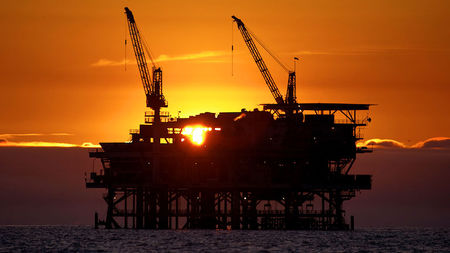 Coral reef at St. Croix, US Virgin Islands. Credit: EPA Coral reef at St. Croix, US Virgin Islands. Credit: EPA
|
On July 18, 1975, the tanker Garbis spilled 1,500 to 3,000 bbls of crude oil into the waters approximately 26 miles south-southwest of the Marquesas Keys, Florida. The oil was blown ashore along a 30-mile stretch of the Florida Keys, east of Key West. The only published description of this spill and its impacts are found in Chan (1977), although the 1976 M. S. thesis of that author at the University of Miami further detailed effects and recovery. The source of the spill, the Garbis, was identified after the publication of both documents.
Environmental impacts
In addition to documenting early impacts, Chan established a series of sites to be monitored over a year following the spill. Since no pre-spill information was available, effect and recovery were judged through comparison with unoiled, biologically similar locations.
Several habitats were impacted, including killing of echinoderms, pearl oysters, and oiled red and black mangrove (Mangrove ecology)s. However, a notable lack of spill effect was found in coral reef areas. Reefs were surveyed by divers immediately following the spill, and subsequently in August and November 1975 and January 1976. Chan attributed this lack of impact to the fact that the reefs were completely submerged during the spill and to calm seas that minimized water column contact with the oil.
Bahía Las Minas, Panama / April 1986
On April 27, 1986, about 240,000 barrels of medium weight crude oil (70 percent Venezuelan crude, 30 percent Mexican Isthmus crude) spilled from a ruptured storage tank at a petroleum refinery at Bahía Las Minas, on the central Caribbean coast of Panama. Of this amount, an estimated 60,000–100,000 barrels spilled into the waters of Bahía Las Minas. This was the largest recorded spill into a sheltered coastal habitat in the tropical Americas. The spill was located close to the Galeta Marine Laboratory of the Smithsonian Tropical Research Institute, and extensively studied.
Response
Six days after the release began, 137 bbls of Corexit 9527 chemical dispersants were applied in one bay and along the northern breakwater at the mouth of the Panama Canal. The dispersants appeared to be ineffective due to the weathered state of the oil and the calm seas. Researchers later concluded that this limited use of dispersant chemicals could not explain the widespread subtidal biological impacts reported.
Impacts
The area where this spill occurred was not pristine before the 1986 incident. Nevertheless, the incident was shown to have widespread lethal and sublethal impacts in all environments examined, including the coral reefs and reef flats. In coral reefs, the cover, size, and diversity of live corals decreased substantially on oiled reefs after the spill. Sublethal impacts included decreased growth, reproduction, and recruitment.
Follow-up studies reported an extensive mortality of both intertidal reef flat corals (Porites spp.) and subtidal reef corals (Diploria clivosa, Porites astreoides, and Siderastrea siderea) that was attributed to the spill. S. siderea was particularly vulnerable, with patches of recent coral death disproportionately common on heavily oiled reefs one year after the spill.
A longer-term follow-up study found higher percentages of recently injured corals at heavily oiled reefs. However, there were peaks immediately after the spill and also during another period spanning 3-5 years post-spill. The latter impacts were attributed to a series of diesel fuel spills at the electrical generation plant in Bahía Las Minas.
Coral growth studies in four native species after the spill initially found reductions in growth for P. astreoides, D. strigosa, M. annularis, and no effect in S. siderea. The lowest annual mean growth rates were measured for 1986, the year of the spill. S. siderea and P. astreoides grew more slowly during the first three years after the spill than they had before. At heavily oiled reefs, growth after the spill declined significantly for S. siderea but not for P. astreoides.
Guzmán et al. (1991) compared cover of common coral species at six reefs before (1985) and after (3 months post) the oil spill at Bahía Las Minas. At one heavily oiled reef, total coral cover decreased by 76 percent in the 0.5-3 m depth range and by 56 percent in the >3–6 m range. Cover decreased less at moderately oiled reefs and either increased or did not change at the unoiled reference reefs. The branching species Acropora palmata nearly disappeared at the heavily oiled site, but increased by 38 percent at the unoiled reefs. This same survey found average colony size and diversity decreased significantly with increased oiling.
Gulf War Spill, Arabian Gulf / January 1991
During the waning days of the Gulf War in 1991, oil was deliberately discharged by the Iraqi military. This resulted in the largest oil spill in history, an estimated 6.3 million barrels. Between 19 and 28 January 1991, oil was released from two major sources: three Iraqi tankers anchored in the Kuwaiti port of Mina Al-Ahmadi, and the Mina Al-Ahmadi Sea Island terminal area.
Impacts
Given the magnitude of this release and the previous coral reef impacts noted at other tropical spills, there were dire expectations of severe impacts to nearshore and offshore reefs in Kuwait and Saudi Arabia. However, to date the extent of coral reef damage directly attributable to the Gulf War spill has been remarkably minor. Surveys of nearshore and offshore reefs conducted in 1992 included a reef at Qit’at Urayfijan that was very likely covered by oil released from at least one tanker and the Mina Al Ahmadi terminal. While the reef is never exposed to the atmosphere, crude oil was assumed to have flowed over it for days. This reef was clearly impacted, mostly in shallower water, with coral death in large colonies of Platygyra as well as in most of the Porites. New growth, however, was observed in nearly all dead portions of coral.
In contrast, conditions at Getty Reef, close to a visibly oiled beach and directly downstream from known release points, showed no evidence of recent coral kills or even stress among Porites, Platygyra, Cyphastrea, Leptastrea, Psammocora, Favia, and Favites, and the associated fish community was especially robust. Other environmental impacts from the war, such as reduced water temperature and lowered ambient light from oil fire smoke, may have obscured actual effects of oil on coral.
Vogt (1995) established six 50-m study transects nearshore and offshore the Saudi Arabian shoreline to document effects and recovery from the spill. On the basis of video recordings made along these transects between 1992 and 1994, Vogt concluded that live coral cover had significantly increased and that the corals offshore from Saudi Arabia had survived the largest spill on record “remarkably unscathed.”
Rose Atoll National Wildlife Refuge, American Samoa / October 1993
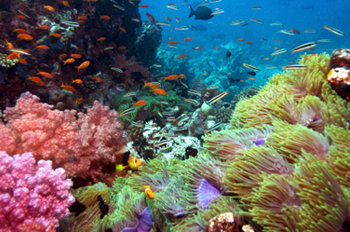 Credit: NOAA Credit: NOAA
|
On October 14, 1993, the Taiwanese fishing vessel Jin Shiang Fa ran aground on the southwestern side of Rose Atoll, a remote coral reef in eastern American Samoa. The grounding resulted in the spillage of 100,000 gallons of diesel fuel and 500 gallons of lube oil and 2,500 pounds of ammonia onto the reef.
Rose Atoll is a National Wildlife Refuge that supports giant clams and a special reef composed of coralline algae. The atoll is inhabited by green sea and hawksbill turtles and was considered one of the most remote and pristine coral reefs in the world. It is a unique coral habitat in Samoa, in that crustose coralline algae (identified as primarily Hydrolithon onkodes and H. craspedium) dominate instead of hermatypic corals. Common reef-building corals include Favia, Acropora, Porites, Montipora, Astreopora, Montastrea, and Pocillopora.
Response
Because of its remote location, and safety concerns, response options at Rose Atoll were very limited. A salvor was underway (from Singapore) but the grounded ship broke up in heavy seas before the salvor arrived. Most of the larger pieces of wreckage and debris were removed, but the stern and associated debris were left in place. A post-spill analysis by a U.S. Coast Guard responder on-scene early in the incident suggests that one option (not pursued at the time) could have been an intentional release of oil when wind and currents were favorable to carry the oil away from the atoll into deeper waters. Instead, when the vessel did break up under storm conditions, winds were onshore, and most of the oil came directly onto the reef and into the lagoon.
Impacts
All of the petroleum products and ammonia were released into the marine environment, over a period estimated as six weeks. Oil was reportedly forced down onto the reef structure by wave action, as was oily debris from the wreck.
Although the injury to the corals from the grounding was judged to be “moderate to high,” it was not possible to ascertain causal factors in a more specific way. Several possibilities for injury pathways were identified:
- Fuel and other contaminant toxicity.
- Mechanical damage from the grounding and subsequent debris impacts.
- Anoxia due to mortalities in the reef community.
- Smothering and scouring from sediments created by the wreck.
- Competition from opportunistic algae and cyanobacteria that was being stimulated by dissolved iron being released during corrosion of the remaining debris.
- Bleaching from direct and indirect impacts of the incident.
Surveys conducted in the weeks following the grounding indicated that the reefs at Rose Atoll had sustained substantial injuries from the physical impact of the vessel and the contaminant releases. The grounding caused major physical damage to the reef framework, gouging large grooves into the atoll and grinding reef into rubble, both during the initial grounding and subsequently as the ship rocked back and forth with the movement of ocean swells. Calcareous sediments generated from the grounding formed large berms, smothering and scouring thousands of square meters of adjacent reef. The vessel eventually broke up within a few weeks after the grounding, before a salvage operation could take place.
The wreckage covered an estimated 9,000 square meters of reef flat. A large amount of ship-related debris was also released onto the reef and spread over an estimated area of 175,000 square meters. The movement of this debris is believed to have further injured coral reef organisms and associated biota through abrasion, breakage, entanglement, smothering, and burial. Additionally, observations indicate the large volume of decomposing dead marine organisms and organic ship debris created a widespread zone of anoxia at the wreck site, which persisted for several months after the grounding and killed some of the surviving sedentary reef organisms in the area. Furthermore, U.S. Fish and Wildlife Service (USFWS) researchers concluded that iron dissolving from the debris was stimulating cyano-bacteria populations (blue-green algae) on the reef crest and neighboring back reef and patch reefs, and causing them to spread to other parts of the atoll that were not directly affected by the grounding.
Because of the lack of recovery after five years, the USFWS conducted additional removal of over 100 tons of debris in 1999. Monitoring showed slight recovery through 2002, but dissolved iron was still elevated and causing a persistent cyanobacterial bloom. It was determined that substantial recovery of the crustose coralline algae would not occur until the metallic debris was removed. With funding from the USCG Oil Spill Liability Trust Fund, the USFWS (United States Fish and Wildlife Service) removed another 100 tons of debris between 2004 and 2007. All debris from the atoll collected from 1999–2007 was surface-transported and dumped at a U.S. Environmental Protection Agency approved offshore dumpsite located three nautical miles north of Rose Island.
Monitoring began in 2005 and will be conducted biennially for ten years, until 2015. This case study indicates how complicated spill response is in remote areas and the importance of monitoring to determine whether recovery is occurring and what factors may be limiting recovery.
Field Experiment Case Studies
Tropical Oil Pollution Investigation in Coastal Systems (TROPICS), Panama: December 1984; September-November 1994; June 2002
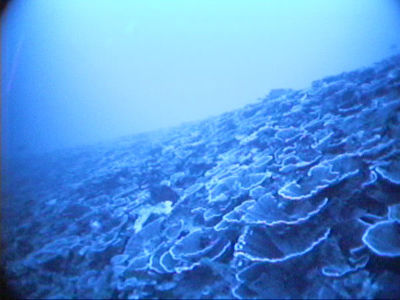 The deep stony coral reef off the island of Maui, which may be the deepest known reef in the US. Credit: NOAA The deep stony coral reef off the island of Maui, which may be the deepest known reef in the US. Credit: NOAA
|
In 1984, the American Petroleum Institute (API) sponsored a multi-year experiment in which a representative tropical system (comprised of mangrove (Mangrove ecology), seagrasses, and coral) was exposed to oil and chemically dispersed oil. The experimental design simulated a severe, but realistic, scenario of two large spills of crude oil in nearshore waters. The original experiment and its findings were detailed in Ballou et al. (1987). The original research team revisited the site in 1994, and collected follow-up data. The sites were again surveyed in 2002 by a team that included one of the original researchers.
Although the studies encompassed oil and chemically dispersed oil effects in mangrove, seagrass, and coral systems, we discuss only oil impacts to corals here.
Treatment
Experimental sites were selected on the Caribbean coast of Panama, with the nearshore half of each site occupied by mangrove forest, fronted by a subtidal seagrass bed and a coral reef. Water depth over seagrass averaged about 0.5 meters and over coral reef, 0.63 meters. Coral reefs were dominated by Porites porites and Agaricia tennifolia. Each of the three sites was treated with oil, dispersed oil, or remained as an untreated reference. The oiled site was treated with 953 liters of Prudhoe Bay crude oil (the amount of oil that would strand from a 100- to 1000-bbl spill) that was released onto a boomed area of the water surface and allowed to remain for about two days. Tides and winds distributed the oil over the study area, and after the exposure period free-floating oil was removed with sorbents.
Monitoring
Chemical and biological monitoring was conducted at five post-spill periods over 20 months. Chemical monitoring, conducted hourly for the first 24 hours, confirmed that sediments and biota were exposed to rising and then rapidly declining dispersed and undispersed oil. For coral reefs, detailed transects were surveyed to measure abundance of epibiota living on the reef surface. Four measurements were taken: total organisms, total animals, corals, and total plants. Growth rates of four coral species (P. porites, A. tennufolia, Montastrea annularis, and Acropora cervicornis) were also measured.
Impacts
The only statistically significant effect documented over the first 20 months at the oiled site was a decrease in coral cover. No significant changes in growth rates of four targeted corals were noted. Ten years later, neither coral cover nor coral growth showed oil impacts. The authors contrasted the finding of no impact from oiling alone to that described by Guzmán et al. (1991) at Bahía Las Minas, where significant effects of oil alone were found in several of the same species studied at TROPICS. Dodge et al. implied that these differences may have been due to the size of the spill at Bahía Las Minas and continued chronic exposure.
Ward et al. (2003) reported that, as of 2002, eighteen years post-oiling, coral cover has increased significantly since 1994, but there were no significant differences among treatments, in both the historical transects and additional Porites photo-quadrats.
Arabian Gulf field experiment/Field dates unknown, reported 1989
This large-scale field experiment conducted on Jurayd Island, off the coast of Saudi Arabia, tested responses of corals to dispersed oil under realistic spill conditions. The design included exposure to crude oil only (Arabian light) among its four exposure scenarios, at exposures of 24 hours and 120 hours. Study plots were established over existing coral reefs that were comprised mostly of Acropora spp. (more than 95 percent), with scattered colonies of Platygyra sp., Goniopora sp., and Porites sp. The plots measured 2 meters by 2 meters, located over approximately 1-meter depth at low tide, and anchored in place.
Treatment
The stated intent of the experiment was to simulate conditions of a typical Arabian Gulf oil spill and not to overwhelm the corals with “extraordinary and catastrophic stresses.” As such, oil was added to test plots to produce a slick of 0.25 mm in thickness, a total of 14 liters in the 24-hour oil-only treatment; and 0.10 mm and 5.63 liters in the 120-hour experiment. Water concentrations of [[hydrocarbon]s] were measured by infrared methods and no water column elevations were detected in the oil-only plots.
Monitoring
The oil-only plots were visually inspected at the end of the 24-hour and 120-hour exposures, and they appeared normal. These areas were monitored for one year, and no extraordinary changes occurred relative to the unoiled plots (seasonal changes in degree of bleaching, however, were noted across all monitored plots). Though dispersed oil appeared to delay the recovery from seasonal bleaching, this was not observed in the oil-only plots.
Growth rates, expressed as skeletal extension along branch axes, showed no correlation to treatment in the 24-hour exposure. There was some indication that growth rates were depressed with 120-hour exposure, but LeGore et al. cautioned that these were not definitive. In summary, after one year of monitoring coral showed no visible effects after exposure to surface oil for 24 hours and for 120 hours. The authors concluded that healthy reef corals can tolerate brief (1 to 5-day) exposures to floating oil with no observable effect. They did note the potential for seasonal susceptibility to exposure in this region in the wintertime when low water temperatures stress corals.
Restoration Case Studies
M/V Wellwood Grounding, Key Largo/August 1994
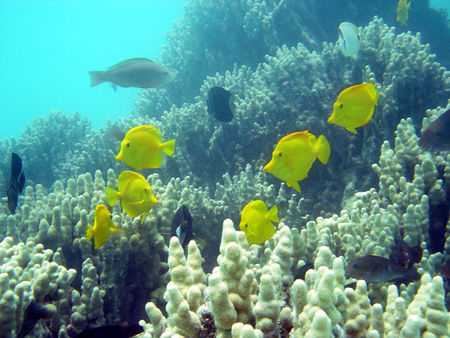 Yellow tangs swimming in coral reef. Credit: NOAA Yellow tangs swimming in coral reef. Credit: NOAA
|
On August 4, 1984, the M/V Wellwood, a 400-foot freighter, ran aground on Molasses Reef in the Key Largo National Marine Sanctuary, causing massive destruction to living corals and underlying reef framework. Subsequent surveys indicated that the grounding fractured 644 square meters of underlying reef framework, with a 1,282-square meter area losing 70 to 100 percent of its live coral cover. Limestone rubble and fine sediment mobilized after the grounding posed further risk of reef injury and delayed recovery.
Restoration
Small-scale pilot studies conducted at the grounding tested the feasibility of stabilizing fractured reef framework, transplanting hard and soft corals into the major damage area, and rebuilding reef topography. Grouting with quick-setting underwater cement restabilized a selected area of fractured reef framework. Loose sand, gravel, and attached algal epiphytes were removed from the site so that the cement could bond properly.
A test coral transplantation plot was established in an area with only moderate fracture damage to the reef framework. In preparation, loose sediment, rock debris, and attached dead soft coral skeletons were removed from the area, but attached dead hard corals were left in place. Representative hard and soft corals from a nearby reef were transplanted to the pilot site. Corals were secured into holes in the reef framework with quicksetting underwater cement, as was used in framework repair.
Recovery
Transplanted hard corals survived, but soft corals were killed at high rates from heavy ocean swells generated by Hurricane Kate in late 1985. Observations indicated soft corals were twisted off at the holdfast base. High mortality of gorgonian corals was observed in areas surrounding the grounding site following the hurricane, some of which may have been caused by debris from the site.
Following the pilot studies, areas flattened by the hull of the ship were partially reconstructed. Divers and airlift bags moved sections of dislodged reef framework and intact head corals back into damaged areas and cemented them permanently into the reef framework. Observations to date suggest that a limited number of gorgonian corals have recruited to cement surfaces, but the material does not sufficiently mimic natural reef rock to warrant its general use.
M/V Alec Owen Maitland and M/V Elpis, Florida Keys/Fall 1989
On October 25, 1989, the 155-foot M/V Alec Owen Maitland ran aground on shallow coral reef in the Florida Keys National Marine Sanctuary. More than 1,600 square meters of formerly pristine coral reef dominated by fire coral and gorgonians were totally or partially destroyed by the time the vessel was removed from the grounding site. On November 11, 1989, the 143-meter freighter M/V Elpis also ran aground nearby in the sanctuary. The ship’s propellers caused two large craters. The grinding of the ship’s hull against the reef created a large rubble field.
Restoration
Following these incidents, efforts were made to repair damaged coral reef resources through structural and biological restoration at 3–4 m depth. At the M/V Alec Owen Maitland grounding site, 40 specially designed pre-cast concrete reef modules or slabs, called “Reef Replicating Units,” were placed in blowholes created by the ship. The reef replicating units, which weighed nearly ten tons each, had upper surfaces textured to somewhat resemble those of living reefs and were intended to provide a hard surface for larvae of coral and other stationary reef organisms, such as sponges, to settle and grow.
Blowholes created by the grounding of the M/V Elpis at 10 m depth were filled to grade with rock and rubble from berms adjacent to the craters. The rock and rubble was covered with large limestone quarry boulders and voids were filled with sand transported by barge to the site. The objective was to recreate a stable foundation to facilitate recruitment of coral colonies. Following structural stabilization of the reef framework, debris was removed from the site.
Structural restoration at both grounding sites was completed in 1995, and biological restoration efforts were commenced in 1996. The biological restoration efforts were intended to enhance or “jump-start” natural biological recovery processes at the sites. This included transplantation of hard and soft corals, as well as sponges and sea fans, onto the hard surfaces of the concrete reef-replicating units at the Maitland grounding site and onto the limestone boulders at the Elpis site.
Monitoring
A monitoring program to assess the health and recovery of the areas affected by the groundings before, during, and after restoration has been in place since 1993. The program includes monitoring for structural integrity, survival, and growth rates of transplanted organisms, and recruitment of new coral colonies and fish populations. Initial monitoring results indicate that the reef framework has been restored, although it will take several years to determine whether the reef organisms will continue to survive and successfully repopulate these areas.
Columbus Iselin, Florida Keys/August 1994
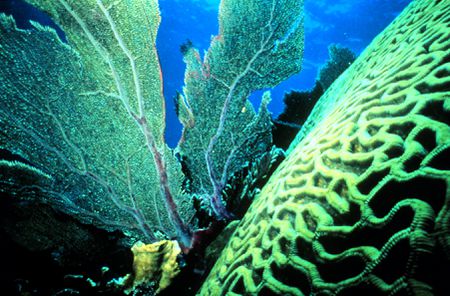 A thriving, healthy Carribean coral reef today: its evolution is an important factor in its future. Credit: NOAA A thriving, healthy Carribean coral reef today: its evolution is an important factor in its future. Credit: NOAA
|
On August 11, 1994 the University of Miami’s 170-foot research vessel Columbus Iselin ran aground on a coral reef off Looe Key, in the Florida Keys National Marine Sanctuary. No damage to coral or other resources was reported as a result of the diesel fuel released. However, the coral reef framework was seriously damaged by the grounding and subsequent salvage operations. Before restoration was started, Hurricanes Georges and Irene and the Groundhog Day storm increased the area of initial injury by displacing reef rock destabilized by the grounding.
Restoration
In order to prevent further damage from loose, dead coral rubble created by the impact of the vessel, NOAA conducted an extensive rubble removal project in the summer after the grounding. Several tons of rubble and ship debris were removed and barged away.
Four coral reef spurs damaged in the grounding were physically reconstructed in the summer of 1999. Using cranes, several layers of five-ton quarried limestone boulders were lowered into the grounding excavation from the deck of a barge. These boulders were held in place by a matrix of composite rebar and tremie concrete. A special, non-separating, underwater concrete was then pumped into the filled excavations. Special fiberglass reinforcing rod and stainless steel anchor rods anchored in the boulders provided additional linkage between the concrete and the boulders. Each spur surface was then dressed with smaller limestone boulders to minimize the concrete surface.
Before pumping in the concrete, divers scrubbed biofouling from the limestone boulders to enhance concrete adhesion. Various-sized limestone rocks and small boulders were placed on the surface of the poured concrete to mimic natural reef outcroppings and to provide more suitable habitat for recruitment of corals and other reef biota. Finally, adult coral colonies were transplanted and embedded into the restored reef framework. This was the first successful structural restoration of a spur and groove reef. The success of this restoration effort indicated that quarried limestone boulders and pumped concrete are suitable materials for rebuilding reef framework. It also supported the conclusion that coral transplanting is an effective technique to help speed recovery of coral communities.
Fortuna Reefer, Puerto Rico/July 1997
The 325-foot container ship Fortuna Reefer ran aground on July 24, 1997 on fringing coral reef off the west coast of Mona Island (Isla de Mona) in Puerto Rico. Mona Island is a pristine natural reserve. The remoteness of the grounding site hampered salvage efforts and the vessel remained aground for eight days. Though the vessel never released oil to the environment, the grounding and subsequent salvage activities damaged the reefs substantially. Much of the damage was attributed to tow and anchor lines.
Restoration
An expedited settlement for natural resource damage, pursued under the Oil Pollution Act of 1990, enabled NOAA and other state and Federal resource agencies to initiate an emergency restoration in September 1997 that was completed within a two-and-a-half month period after the grounding. The objectives of the emergency restoration were to quickly reestablish the physical structure of the coral reef community and to reduce coral mortality.
The 6.8-acre grounding site was dominated by a well-established reef of branching elkhorn coral, Acropora palmata, at a depth ranging between 3 and 9 meters. Restoration consisted of immobilizing loose branches of elkhorn coral by securing them to the reef buttress and to existing elkhorn coral framework using stainless steel wire and nails. Several stabilization methods were tested. Due to the density and hardness of the reef structure, the method selected consisted of drilling holes into the reef, driving nails into the holes, and wiring corals to the reef. Stainless steel materials were used to minimize corrosion and increase the longevity of the repair effort. Other materials tested, such as plastic tie wraps, did not perform as well in the wave surge. The timely removal of injured coral from sand areas prevented them from being smothered and also minimized abrasion damage to broken coral pieces from swell and wave motion. Upon completion, 1,857 coral fragments had been stabilized.
Monitoring
Monitoring stations were established to track the success of the restoration effort. Monitoring will include tracking survival of transplants and success of the transplant materials and techniques employed.
Glossary
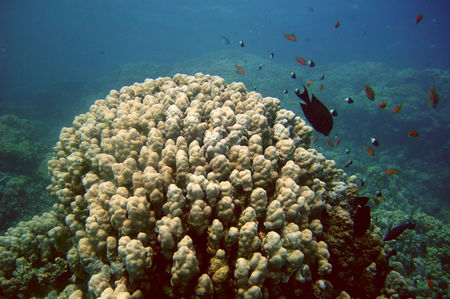 A healthy coral reef environment. Credit: NASA A healthy coral reef environment. Credit: NASA
|
- acroporid coral – canopy-forming species of coral belonging to the family Acroporidae. These are the dominant species of corals found worldwide.
- Anthozoa – a class of Cnidaria that includes the stony corals, soft corals, sea anemones, zoanthids, gorgonians, and corallimorpharians.
- Anthropogenic – caused by humans.
- Apron reef – the initial stages of a fringing reef; it is discontinuous and covers a small area.
- Atoll – a horseshoe-shaped or circular array of coral reefs containing a lagoon in the center, and capping the perimeter of a submerged volcanic island.
- Back reef – shoreward side of a reef, including the area and sediments between the reef crest and land.
- Barrier reef – a reef running roughly parallel to shore and separated from it by a lagoon of considerable depth and width; it may lie a great distance from a continental coast and is often interrupted by passes or channels.
- Benthic – bottom:dwelling; living on or under the sediments or other substratum.
- Bioenergetic – metabolic processes that are responsible for supplying energy to an organism.
- Black band disease (BBD) – coral disease containing a photosynthetic cyanobacterium that kills coral tissue by a lack of oxygen and exposure to hydrogen sulfide produced by the bacterium.
- Bleaching – the process during which symbiotic zooxanthellae are expelled from host coral tissues.
- Broadcast spawning – method of reproduction utilized by some corals in which gametes are released into the water column.
- Brooding – method of reproduction in some corals in which fertilization and larval development occur internally.
- Calcareous – made of calcium carbonate.
- Cnidaria – a phylum of invertebrate coelenterate animals having a simple, two-layered body plan; includes jellyfish, hydroids, soft corals, sea anemones, and corals.
- Coral – a general term used to describe a group of benthic cnidarians; usually indicates the presence of a calcium carbonate skeleton secreted by the animal.
- Coral reef – a wave-resistant structure resulting from skeletal deposition and cementation of hermatypic corals, calcareous algae, and other calcium carbonate-secreting organisms.
- Coralline algae – heavily calcified, encrusting red algae.
- Corallite – a skeletal cup secreted by a coral.
- Corallivore – an organism that eats coral.
- Coriolis Effect – a rotational effect generated by the movement of a fluid over the Earth’s rotating surface.
- Cyanobacteria – one to many-celled aquatic organisms, formerly known as blue-green algae, that photosynthesize and produce oxygen.
- Extension rate – accretion or lengthening of a branching coral caused by calcification.
- Flow-through exposure – a laboratory setup in which organisms are held in continuously flowing water—in contrast to static exposure, in which organisms are held in a given volume of water with no exchange.
- Fringing reef – a reef that grows adjacent to the shoreline.
- Gametes – the sexual products of an organism such as eggs and sperm.
- Gonochoric – each colony is either male or female.
- Habitat – place or environment where a particular species lives.
- Hermatypic – reef-building coral.
- Histological – referring to tissue structure.
- Lagoon – a warm, shallow, quiet waterway separated from the open sea by a reef crest.
- Leeward – the side of an island or reef that faces away from the prevailing wind.
- Massive – when referring to coral types, describes a skeleton formed as a solid block rather than being branched or plate-like. Most massive corals are mound-shaped.
- Mass spawning – simultaneous release of gametes by multiple species usually involving a large number of individuals.
- Natural recruitment – the way a population reproduces itself.
- Nominal exposure – oil exposure concentrations based on the proportions of oil added to water (without actually measuring how much oil was ultimately mixed into the water).
- Octocorals – anthozoans of the subclass Octocorallia, commonly called soft corals, sea fans, and whips.
- PAH – polynuclear aromatic hydrocarbon.
- ppm – parts per million.
- ppt – parts per thousand.
- Patch reef – clump of coral colonies unattached to a major reef structure that has a defined reef slope, crest, and reef flat.
- Photic zone – the vertical zone in the ocean extending from the surface to that depth permitting photosynthetic activity.
- Planula – a planktonic larval form produced by some anthozoans.
- Polyp – an individual of a solitary cnidarian or one member of a cnidarian colony.
- Pulse exposure – to simulate a spill-type release in a flow-through laboratory setting, an initial and relatively high concentration of a contaminant is allowed to dissipate under continuous water flow.
- Reef crest – shallowest seaward margin of reef.
- Reef slope – reef seaward of reef crest.
- Scleractinia – order of the Phylum Cnidaria, usually producing calcareous skeletons with six-part symmetry.
- Sessile – immobile because of attachment to a substratum.
- SST – sea surface temperatures; considered elevated when they are at least 1 degree C higher than the summer maximum.
- Sublethal – toxic effect that does not cause death, but impairs the organism in various ways (includes in corals reduced ability to retract polyps, impaired feeding ability, impaired ability to clear sediment, impaired settlement of larvae).
- Vegetative reproduction – asexual reproduction, such as through budding or fragments.
- WAF – water-accommodated fraction.
- WSF – Water-soluble fraction.
- Weathering – changes in the physical and chemical properties of oil due to natural processes, including evaporation, emulsification, dissolution, photo-oxidation, and biodegradation.
- White band disease (WBD) – coral disease affecting only acroporid corals, it appears in a band form, and kills coral tissues as it spreads over the entire coral structure.
- Windward – the side of an island or reef that faces the prevailing wind.
- Zooxanthellae – a group of dinoflagellates living symbiotically in association with one of a variety of invertebrate groups (e.g., corals).
Coral Websites
- NOAA Coral Reef Conservation Program - NOAA’s main coral website. Links to bleaching predictions for Florida Keys, coral health and monitoring program, NOAA, Marine Sanctuaries, U.S. Coral Reef Task force.\
- NOAA Office of Response and Restoration - NOAA website that includes response guidance such as dispersant and in-situ burning use, SMART monitoring, spill case histories, and spill response software tools.
- NOAA Satellite and Information Service, Coral Bleaching Products - NOAA’s bleaching hot spot website with satellite data.
- NOAA Coral Reef Watch - NOAA’s satellite bleaching research website.
- NOAA Damage Assessment, Remediation, and Restoration Program - Includes descriptions of several coral restoration sites, including Fortuna Reefer, Elpis, and Alec Owen Maitland incidents.
- NOAA National Marine Sanctuaries - With links to existing and proposed sanctuaries. Includes link to Columbus Iselin restoration site.
- Florida Keys National Marine Sanctuary
- EPA Coral Reef Protection
- NOAA’s Coral Health and Monitoring Program
- State of Florida Coral Reef Conservation Program
- State of Hawai'i Department of Land and Natural Resources
- Hawai’i Coral Reef Network
- Reef Relief- nonprofit reef protection organization.
- Field Guide to Western Atlantic Coral Diseases and Other Causes of Coral Mortality - Global coral disease database.
- Coral Reefs and Mangroves of the World - Joint page from numerous government and non-government data sources.
- Great Barrier Reef Marine Park Authority - Links to published papers, and numerous sources of information on coral and associated habitats.
Further Reading
Oil Toxicity to Corals
- Bak, R. P. M. 1987. Effects of chronic oil pollution on a Caribbean coral reef. Marine Pollution Bulletin 18: 534–539.
- Bak, R. P. M. and J. H. B. W. Elgershuizen. 1976. Patterns of oil-sediment rejection in corals. Marine Biology 37: 105–113.
- Ballou, T. G., R. E. Dodge, S. C. Hess, A. H. Knap, and T. D. Sleeter. 1987. Effects of a dispersed and undispersed crude oil on mangroves, seagrasses, and corals. API Publication No. 4460, API Health and Environmental Sciences Department. Washington, D.C.: American Petroleum Institute. 198 pp.
- Benson, A. A. and L. Muscatine. 1974. Wax in coral mucus: energy transfer from corals to reef fishes. Limnology and Oceanography 19: 810–814.
- Birkeland, C., A. A. Reimer, and J.R. Young. 1976. Survey of marine communities in Panama and experiments with oil. EPA Report EPA-60013-76-028. Narragansett: U.S. Environmental Protection Agency. 177 pp.
- Burns, K. A. and A. H. Knap. 1989. The Bahía Las Minas oil spill: Hydrocarbon uptake by reef building corals. Marine Pollution Bulletin 20: 391–398.
- Cook, C. B. and A. H. Knap. 1983. The effects of crude oil and chemical dispersant on photosynthesis in the brain coral, Diploria strigosa. Marine Biology 78: 21–27.
- Cram, S., C. Ponce de León, P. Fernández, I. Sommer, H. Rivas, and L. M. Morales. 2006. Assessment of Trace Elements and Organic Pollutants From a Marine Oil Complex into the Coral Reef System of Cayo Arcas, Mexico. Environmental Monitoring and Assessment 121: 127–149.
- Dodge, R. E., B. J. Baca, A. H. Knap, S. C. Snedaker and T. D. Sleeter. 1995. The effects of oil and chemically dispersed oil in tropical ecosystems: 10 years of monitoring experimental sites. MSRC Technical Report Series 95-014. Washington, D.C.: Marine Spill Response Corporation. 93 pp.
- Dodge, R. E., S. C. Wyers, H. R. Frith, A. H. Knap, S. R. Smith and T. D. Sleeter. 1984. The effects of oil and oil dispersants on the skeletal growth of the hermatypic coral Diploria strigosa. Coral Reefs 3: 191–198.
- Downs, C. A., E. Mueller, S. Phillips, J. E. Fauth. and C. M. Woodley. 2000. A molecular biomarker system for assessing the health of coral (Montastrea faveolata) during heat stress. Marine Biotechnology 2: 533–544.
- Downs, C. A., R. H. Richmond, W. J. Mendiola, L. Rougee, G. K. Ostrander. 2006. Cellular Physiological Effects of the M. V. Kyowa Violet Grounding on the Hard Coral Porites Lobata. Environmental Toxicology and Chemistry 25: 3171–3180.
- Elgershuizen, J. H. B. W. and H. A. M. deKruijf. 1976. Toxicity of crude oils and a dispersant to the stoney coral Madracis mirabilis. Marine Pollution Bulletin 7: 22–25.
- Epstein, N., R. P. M. Bak, and B. Rinkevich. 2000. Toxicity of third generation dispersants and dispersed Egyptian crude oil on Red Sea coral larvae. Marine Pollution Bulletin 40: 497–503.
- Fucik, K. W., T. J. Bright, and K. S. Goodman. 1984. Measurements of damage, recovery, and rehabilitation of coral reefs exposed to oil. In J. Cairns and A. L. Buikema, eds., Restoration of Habitats Impacted by Oil Spills, Butterworth, London, pp. 115–133.
- Guzmán, H. M., K. A. Burns, and J. B. C. Jackson. 1994. Injury, regeneration and growth of Caribbean reef corals after a major oil spill in Panama. Marine Ecology Progress Series 105: 231–241.
- Guzmán, H. M., J. B. C. Jackson and E. Weil. 1991. Short-term ecological consequences of a major oil spill in Panamanian subtidal coral reefs. Coral Reefs 10: 1–12.
- Guzmán, H. M. and I. Holst. 1993. Effects of chronic oil-sediment pollution on the reproduction of the Caribbean reef coral Siderastrea siderea. Marine Pollution Bulletin 26: 276–282.
- Harrison, P. L., J. C. Collins, C. G. Alexander, and B. A. Harrison. 1990. The effects of fuel oil and dispersant on the tissues of a staghorn coral Acropora formosa: A pilot study. In: Scientific Input to Oil Spill Response, Proceedings of Second National Workshop on Role of Scientific Support Co-ordinator, HMAS Cerberus (Hastings, Victoria), March 26–30, 1990, pp. 51–61.
- Jackson, J., J. Cubit, B. Keller, V. Batista, K. Burns, H. Caffey, R. Caldwell, S. Garrity, C. Getter, C. Gonzalez, H. Guzmán, K. Kaufmann, A. Knap, S. Levings, M. Marshall, R. Steger, R. Thompson, and E. Weil. 1989. Ecological effects of a major oil spill on Panamanian coastal marine communities. Science 243: 37–44.
- Johannes, R. E. J. Maragos and S. L. Coles. 1972. Oil damages corals exposed to air. Marine Pollution Bulletin 3: 29–30.
- Keller, B. D. and J. B. C. Jackson, eds. 1993. Long-term assessment of the oil spill at Bahía Las Minas, Panama, synthesis report, volume 1: Executive summary. OCS Study MMS 93-0047. New Orleans: U.S. Department of the Interior, Minerals Management Service, Gulf of Mexico OCS Region. 129 pp.
- Kennedy, C. J., N. J. Gassman, and P. J. Walsh. 1992. The fate of benzo[a]pyrene in the scleractinian corals Favia fragrum and Montastrea annularis. Marine Biology 113: 313–318.
- Knap, A. H., J. E. Solbakken, R. E. Dodge, T. D. Sleeter, S. Wyers, and K. H. Palmork. 1982. Accumulation and elimination of (9—14C) phenanthrene in the reef-building coral (Diploria strigosa). Bulletin of Environmental Contamination and Toxicology 28: 281–284.
- Knap, A. H., T. D. Sleeter, R. E. Dodge, S. C. Wyers, H. R. Frith, and S. R. Smith. 1983. The effects of oil spills and dispersants use on corals: A review and multidisciplinary experimental approach. Oil and Petrochemical Pollution 1: 157–169.
- Kushmaro, A., G. Henning, D. K. Hofmann, and Y. Benayahu. 1996. Metamorphosis of Heteroxenia fuscescens planulae (Cnidaria: Octocorallia) is inhibited by crude oil: A novel short term toxicity bioassay. Marine Environmental Research 43: 295–302.
- Lane, A. and P. L. Harrison. 2000. Effects of oil contaminants on survivorship of larvae of the scleractinian reef corals Acropora tenuis, Goniastrea aspera and Platygyra sinensis from the Great Barrier Reef. In: Proceedings of the 9th International Coral Reef Symposium, Vol. 1, pp. 403–408.
- Lewis, J. B. 1971. Effects of crude oil and oil spill dispersant on reef corals. Marine Pollution Bulletin 2: 59–62.
- Loya, Y. and B. Rinkevich. 1979. Abortion effect in corals induced by oil pollution. Marine Ecology Progress Series 1: 77–80.
- Loya, Y. and B. Rinkevich. 1980. Effects of oil pollution on coral reef communities. Marine Ecology Progress Series 3: 167–180.
- Martinez, M. D. C. G., P. R. Romero, and A. T. Banaszak. 2007. Photoinduced toxicity of the polycyclic aromatic hydrocarbon, fluoranthene, on the coral, Porites divaricata. Journal of Environmental Science and Health, Part A, 42: 1495–1502.
- Neff, J. M. and J. W. Anderson. 1981. Response of Marine Animals to Petroleum and Specific Petroleum Hydrocarbons. New York: John Wiley & Sons, 177 pp.
- Negri, A. P. and A. J. Heyward. 2000. Inhibition of fertilization and larval metamorphosis of the coral Acropora millepora (Ehrenberg, 1834) by petroleum products oil contamination along oil tanker routes off the United Arab Emirates (The Arabian Gulf and the Gulf of Oman). Marine Pollution Bulletin 7: 420–427.
- NOAA. 1995. Barge Morris J. Berman spill, NOAA’s scientific response. HAZMAT Report 95-10. Seattle: Hazardous Materials Response and Assessment Division, National Oceanic and Atmospheric Administration. 63 pp.
- Peters, E. C., P. A. Meyers, P. P. Yevich, and N. J. Blake. 1981. Bioaccumulation and histopathological effects of oil on a stony coral. Marine Pollution Bulletin 12: 333–339.
- Poulsen, A., K. Burns, J. Lough, D. Brinkman, and S. Delean. 2006. Trace analysis of hydrocarbons in coral cores from Saudi Arabia. Organic Geochemistry 37: 1913–1930.
- Ray, J. P. 1980. The effects of petroleum hydrocarbons on corals. In: Petroleum and the Marine Environment, Proceedings of Petromar 80, Graham and Trotman Ltd., London.
- Readman, J. W., I. Tolosa, A. T. Law, J. Bartocci, S. Azemard, T. Hamilton, L. D. Mee, A. Wagener, M. Le Tissier, C. Roberts, N. Downing, and A. R. G. Price. 1996. Discrete bands of petroleum hydrocarbons and molecular organic markers identified within massive coral skeletons. Marine Pollution Bulletin 32: 437–443.
- Reimer, A. A. 1975. Effects of crude oil on corals. Marine Pollution Bulletin 6:39-44.
- Rinkevich, B. and Y. Loya. 1977. Harmful effects of chronic oil pollution on a Red Sea scleractinian coral population. In D. L. Taylor (ed.), Third International Coral Reef Symposium, Miami, Vol. 2, pp. 585–591, University of Miami, Florida.
- Rinkevich, B. and Y. Loya. 1979. Laboratory experiments on the effects of crude oil on the Red Sea coral Stylophora pistillata. Marine Pollution Bulletin 10: 328–330.
- Rinkevich, B. and Y. Loya. 1983. Response of zooxanthellae photosynthesis to low concentrations of petroleum hydrocarbons. Bulletin of the Institute of Oceanography and Fisheries 9: 109–115.
- Shafir, A., J. Van Rijn, and B. Rinkevich. 2007. Short and long term toxicity of crude oil and oil dispersants to two representative coral species. Environmental Science & Technology 41: 5571–5574.
- Rougée, L., C. A. Downs, R. H. Richmond, and G. K. Ostrander. 2006. Alteration of Normal Cellular Profiles in the Scleractinian Coral (Pocillopora Damicornis) Following Laboratory Exposure to Fuel Oil. Environmental Toxicology and Chemistry 25: 3181–3187:
- Te, F. T. 1991. Effects of two petroleum products on Pocillopora damicornis planulae. Pacific Science 45: 290–298.
- Villaneuva, R. D., M. N. E. Montano, and H. T. Yap. 2008. Effects of natural gas condensate - water accomodated fraction on coral larvae. Marine Pollution Bulletin 56: 1422–1428.
- Wyers, S. C., H. R. Frith, R. E. Dodge, S. R. Smith, A. H. Knap, and T. D. Sleeter. 1986. Behavioural effects of chemically dispersed oil and subsequent recovery in Diploria strigosa (Dana). Marine Ecology 7: 23–42.
Response Methods For Coral Reef Areas
In-situ Burning
- Blenkinsopp, S., G. Sergy, K. Doe, G. Wohlgeschaffen, K. Li, and M. Fingas. 1996. Toxicity of the weathered crude oil used at the Newfoundland Offshore Burn Experiment (NOBE) and the resultant burn residue. Spill Science & Technology Bulletin 3: 277–280.
- Blenkinsopp, S., G. Sergy, K. Doe, G. Wohlgeschaffen, K. Li, and M. Fingas. 1997. Evaluation of the toxicity of the weathered crude oil used at the Newfoundland Offshore Burn Experiment (NOBE) and the resultant burn residue. In Proceedings of the Twentieth Arctic and Marine Oilspill Program (AMOP) Technical Seminar, Vancouver, British Columbia, June 11–13, 1997, pp. 677–684.
- Buist, I. A., S. L. Ross, B. K. Trudel, E. Taylor, T. G. Campbell, P. A. Westphal, M. R. Myers, G. S. Ronzio, A. A. Allen, and A. B. Nordvik. 1994. The Science, Technology and Effects of Controlled Burning of Oil Spills at Sea. MSRC Technical Report Series 94-013. Washington, D.C.: Marine Spill Response Corporation. 382 pp.
- Daykin, M, A. Tang, G. Sergy, D. Aurand, G. Shigenaka, and Z. Wang. 1994. Aquatic toxicity resulting from in-situ burning of oil on water. In Proceedings of the Seventeenth Arctic and Marine Oilspill Program (AMOP) Technical Seminar, Vancouver, British Columbia, June 18–10, 1994, pp. 1165–1193.
- Daykin, M. M., P. A. Kennedy, and A. Tang. 1995. Aquatic toxicity from in-situ oil burning. Ottawa, Ontario: Environment Canada, Emergencies Science Division, Environmental Technology Centre 62 pp.
- Gulec, I. and D. A. Holdway. 1999. The toxicity of laboratory burned oil to the amphipod Allorchestes compressa and the snail Polinices conicus. Spill Science and Technology 5: 135–139.
- S. L. Ross Environmental Research, Ltd. 1998. Identification of Oils that Produce Nonbuoyant In-situ Burning Residues and Methods for their Recovery. Prepared for American Petroleum Institute and Texas General Land Office by S. L. Ross, Ottawa, Canada. 50 p.
Dispersants
- American Society for Testing and Materials (ASTM). 1987. Ecological considerations for the use of chemical dispersants in oil spill response - coral reefs. pp. 909–923, 932–938 and 941–961, Annual Book of Standards, v. 11.04. Philadelphia: ASTM.
- Aurand, D. 1995. A research program to facilitate resolution of ecological issues affecting the use of dispersants in marine spill response. In P. Lane (ed). The Use of Chemicals in Oil Spill Response. ASTM 1252, American Society for Testing and Materials, Philadelphia, pp. 172–190.
- Ballou, T. G., S. C. Hess, R. E. Dodge, A. H. Knap, and T. D. Sleeter. 1989. Effects of untreated and chemically dispersed oil on tropical marine communities: A long-term field experiment. In Proceedings of the 1989 International Oil Spill Conference, San Antonio, February 13–16, 1989, pp. 447–454.
- Cook, C. B. and A. H. Knap. 1983. Effects of crude oil and chemical dispersant on photosynthesis in the brain coral Diploria strigosa. Marine Biology 78: 21–27.
- Dodge, R. E., S. C. Wyers, H. R. Frith, A. H. Knap, S. R. Smith, and T. D. Sleeter. 1984. The effects of oil and oil dispersants on skeletal growth of the hermatypic coral Diploria strigosa. Coral Reefs 3: 191–198.
- Epstein, N., R. P. Bak, and B. Rinkevich. 2000. Toxicity of third generation dispersants and dispersed Egyptian crude oil on Red Sea coral larvae. Marine Pollution Bulletin 40: 497–503.
- George-Ares, A. and J. R. Clark. 2000. Aquatic toxicity of two Corexit dispersants. Chemosphere 40: 897–906.
- Green, D. R., J. Buckley, and B. Humphrey. 1982. Fate of chemically dispersed oil in the sea: A report on two field experiments. Technology Development Report EPS-4-EC-82-5. Ottawa, Ontario: Environment Canada. 125 pp.
- Harrison, P. L., J. C. Collins, C. G. Alexander, and B. A. Harrison. 1990. The effects of fuel oil and dispersant on the tissues of a staghorn coral Acropora formosa: A pilot study. In Scientific Input to Oil Spill Response, Proceedings of Second National Workshop on Role of Scientific Support Co-ordinator, HMAS Cerberus (Hastings, Victoria), March 26–30, 1990, pp. 51–61.
- Knap, A. H., T. D. Sleeter, R. E. Dodge, S. C. Wyers, H. R. Frith, and S. R. Smith. 1983. The effects of oil spills and dispersant use on corals. A review and multidisciplinary experimental approach. Oil and Petrochemical Pollution 1: 157–269.
- Lane, A. and P. L. Harrison. 2000. Effects of oil contaminants on survivorship of larvae of the scleractinian reef corals Acropora tenuis, Goniastrea aspera and Platygyra sinensis from the Great Barrier Reef. In: Proceedings of the 9th International Coral Reef Symposium, Vol. 1, pp. 403–408.
- Legore, S., D. S. Marszalek, L. J. Danek, M. S. Tomlinson, J. E. Hoffman, and J. E. Cuddeback. 1989. Effect of chemically dispersed oil on Arabian Gulf corals: A field experiment. In Proceedings of the 1989 International Oil Spill Conference, San Antonio, February 13–16, 1989, pp. 375–380.
- Lessard, R. R. and G. Demarco. 2000. The significance of oil spill dispersants. Spill Science and Technology Bulletin 6: 59–68.
- Mackay, D., S. Chang, and P. G. Wells. 1982. Calculation of oil concentrations under chemically dispersed slicks. Marine Pollution Bulletin 13: 278–263.
- National Research Council (NRC). 1989. Using Oil Spill Dispersants on the Sea. Washington, D.C.: National Academy Press. 335 pp.
- National Research Council. 2005. Oil Spill Dispersants: Efficacy and Effects. National Academy Press, Washington, DC. 377 pp.
- Negri, A. P. and A. J. Heyward. 2000. Inhibition of fertilization and larval metamorphosis of the coral Acropora millepora (Ehrenberg, 1834) by petroleum products oil contamination along oil tanker routes off the United Arab Emirates (The Arabian Gulf and the Gulf of Oman). Marine Pollution Bulletin 7: 420–427.
- Shafir, A., J. Van Rijn, and B. Rinkevich. 2007. Short and long term toxicity of crude oil and oil dispersants to two representative coral species. Environmental Science & Technology 41: 5571–5574.
- Singer, M. M., S. Jacobson, M. Hodgins, R. S. Tjeerdema, and M. S. Sowby. 1999. Acute toxicological consequences of oil dispersal to marine organisms. In Proceedings of the 1999 International Oil Spill Conference, Seattle, March 8–11, 1999, pp. 1031–1033.
- Swannell, R. P and F. Daniel. 1999. Effect of dispersants on oil biodegradation under simulated marine conditions. In Proceedings of the 1999 International Oil Spill Conference, Seattle, March 8–11, 1999, pp. 169–176.
- Thorhaug, A. and 12 authors. 1991. Dispersant use for tropical nearshore waters: Jamaica. In Proceedings of the 1991 International Oil Spill Conference, San Diego, March 4–7, 1991, pp. 415–418.
- van Ouenhoven, J. A. C. M. 1983. The Hasbah 6 (Saudi Arabia) blowout: The effects of an international oil spill as experienced in Qatar. In Proceedings of the 1983 International Oil Spill Conference, San Antonio, February 28–March 3, 1983, pp. 381–388.
- Wells, P. G. 1984. The toxicity of oil spill dispersants to marine organisms: A current perspective. In T. E. Allen (ed), Oil Spill Chemical Dispersants: Research, Experience and Recommendations. STP 840. Philadelphia: American Society for Testing and Materials. pp. 177–202.
- Wyers, S. C., H. R. Frith, R. E. Dodge, S. R. Smith, A. H. Knap, and T. D. Sleeter. 1986. Behavioral effects of chemically dispersed oil and subsequent recovery in Diploria stirigosa (Dana). Marine Ecology 7: 23–42.
Coral Reef Restoration
- Connell, J. H., T. P. Hughes, and C. C. Wallace. 1997. A 30-year study of coral abundance, recruitment, and disturbance at several scales in space and time. Ecological Monographs 67: 461–488.
- Cubit, J. D., C. D. Getter, J. B. Jackson, S. D. Garrity, H. M. Caffey, R. C. Thompson, D. Weil, and M. J. Marshall. 1987. An oil spill affecting coral reefs and mangroves on the Caribbean coast of Panama. Proceedings of the 1987 International Oil Spill Conference, April 6–9, 1987, Baltimore, pp. 401–406.
- Dodge, R. E., A. H. Knap, S. C. Snedaker, and T. D. Sleeter. 1995. The Effects of Oil and Dispersed Oil in Tropical Ecosystems: 10 Years of Monitoring Experimental Sites. MSRC Technical Report Series 95-014. Washington, D.C.: Marine Spill Response Corporation, 82 pp. + app.
- Done, T. J. 1999. Coral community adaptability to environmental change at the scales of regions, reefs and reef zones. American Zoologist 39: 66–79.
- Endean, R. 1976. Destruction and recovery of coral reef communities. In: Biology and Geology of Coral Reefs, Volume III: Biology 2. O. A. Jones and R. Endean (eds.), Academic Press, New York, pp. 215-254.
- Gittings, S. R., T. J. Bright, A. Choi, and R. R. Barnett. 1998. The recovery process in a mechanically damaged coral reef community: recruitment and growth. Proceedings of the Sixth International Coral Reef Symposium, Townsville, Australia, August 8th–12th, 1988, pp. 225–230.
- Grigg, R. W., and J. E. Maragos. 1974. Recolonization of Hermatypic corals on submerged lava flows in Hawaii. Ecology 55: 387–95.
- Guzmán, H. M., K. A. Burns, and J. B. C. Jackson. 1994. Injury, regeneration and growth of Caribbean reef corals after a major oil spill in Panama. Marine Ecology Progress Series 105: 231–241.
- Hudson, J. H. and W. B. Goodwin. 1997. Restoration and growth reate of hurricane damaged pillar coral (Dendrogyra cylindrus) in the Key Largo National Marine Sanctuary, Florida. Proceedings of the Eighth International Coral Reef Symposium, Panama, June, 1996, pp. 567–570.
- Hughes, T. P. and J. B. C. Jackson. 1980. Do corals lie about their age? Some demographic consequences of partial mortality, fission and fusion. Science 209: 713–715.
- Jackson, J. B. C, J. D. Cubit, B. D. Keller, V. Batista, K. Burns, H. M. Caffey, R. L. Caldwell, S. D. Garrity, C. D. Getter, C. Gonzalez, H. M. Guzmán, K. W. Kaufmann, A. H. Knap, S. C. Levings, M. J. Marshall, R. Steger, R. C. Thompson, and E. Weil. 1989. Ecological effects of a major oil spill on Panamanian Coastal Marine Communities. Science 243: 37–44.
- Loya, Y. 1976. Recolonization of Red Sea corals affected by natural catastrophes and man-made perturbations. Ecology 57: 278–289.
- Maragos, J. E. 1992. Restoring coral reefs with emphasis on Pacific reefs. In: Restoring the Nation’s Marine Environment, Gordon W. Thayer, (ed.), Maryland Sea Grant Books, College Park.
- Maragos, J. E. 1994. Reef and coral observations on the impact of the grounding of the longliner Jin Shiang Fa at Rose Atoll, American Samoa. Honolulu: U.S. Fish and Wildlife Service, Pacific Island Office. 27 pp.
- Pearson, R. G. 1981. Recovery and Recolonization of Coral Reefs. Marine Ecology Progress Series 4: 105–122.
- Schmahl, G. P., D. R. Deis, and S. K. Shutler. 2006. Cooperative natural resource damage assessment and coral reef restoration at the container ship Houston grounding in the Florida Keys National Marine Sanctuary. In: Precht WF, editor. Coral reef Restoration Handbook. Boca Raton, Florida: CRC Press. p. 235–56.
- Shafir, S., J. Van Rijn, and B. Rinkevich. 2007. Short and long toxicity of crude oil and oil dispersants to two representatives coral species. Environ. Sci. Technol. 41: 5571–5574.
- Wilkinson, C. R. 1999. Global and local threats to coral reef functioning and existence: review and predictions. Marine Freshwater Research 50: 867–78.
- Zengel, S. and H. Hinkeldey. 2001. Coral reef recovery: literature review and recommendations for damage assessment and restoration planning. Silver Spring, Maryland: Research Planning, Inc.; 46 p.
Coral Case Studies
R. C. Stoner, Wake Island/September 1967
- Gooding, R. M. 1971. Oil pollution on Wake Island from the tanker R. C. Stoner. Special Scientific Report--Fisheries No. 636. Seattle: NOAA/National Marine Fisheries Service. 12 pp.
Ocean Eagle spill, Puerto Rico / March 1968 and Morris J. Berman, Puerto Rico / January 1994
- Cerame-Vivas, M. T. 1968. The wreck of the Ocean Eagle. Sea Frontiers 15: 222–231.
- NOAA. 1992. Oil spill case histories 1967–1991, Summaries of significant U.S. and international spills. Report No. HMRAD 92-11. Seattle: NOAA/Hazardous Materials Response and Assessment Division.
- NOAA. 1995. Barge Morris J. Berman spill, NOAA’s scientific response. HAZMAT Report 95-10. Seattle: NOAA/Hazardous Materials Response and Assessment Division. 63 pp.
SS Witwater spill, Panama / December 1968
- Birkeland, C., A. A. Reimer, and J. R. Young. 1976. Survey of marine communities in Panama and experiments with oil. EPA Report EPA-60013-76-028. Narragansett: U.S. Environmental Protection Agency. 177 pp.
- Rützler, K. and W. Sterrer. 1970. Oil pollution. Damage observed in tropical communities along the Atlantic seaboard of Panama. Bioscience 20: 222–224.
Zoe Colocotronis / March 1973
- Nadeau, R. J., and E. T. Bergquist. 1977. Effects of the March 18, 1973 oil spill near Cabo Rojo, Puerto Rico on tropical marine communities. In Proceedings of the 1977 International Oil Spill Conference, New Orleans, March 8–10, pp. 535–538.
- Page, D. S., D. W. Mayo, J. F. Cooley, E. Sorenson, E. S. Gilfillan , and S. A. Hanson. 1979. Hydrocarbon distribution and weathering at a tropical oil spill site. In Proceedings of the 1979 International Oil Spill Conference, Los Angeles, March 19–22, 1979, pp. 709–712.
T/V Garbis spill, Florida Keys / July 1975
- Chan, E. I. 1977. Oil pollution and tropical littoral communities: Biological effects of the 1975 Florida Keys oil spill. In Proceedings of the 1977 International Oil Spill Conference, New Orleans, March 8–10, pp. 539–542.
Bahía Las Minas, Panama / April 1986
- Guzmán, H. M. and I. Holst. 1993. Effects of chronic oil-sediment pollution on the reproduction of the Caribbean reef coral Siderastrea siderea. Marine Pollution Bulletin 26: 276–282.
- Jackson, J., J. Cubit, B. Keller, V. Batista, K. Burns, H. Caffey, R. Caldwell, S. Garrity, C. Getter, C. Gonzalez, H. Guzmán, K. Kaufmann, A. Knap, S. Levings, M. Marshall, R. Steger, R. Thompson, and E. Weil. 1989. Ecological effects of a major oil spill on Panamanian coastal marine communities. Science 243: 37–44.
- Keller, B. D. and J. B. C. Jackson, eds. 1993. Long-term Assessment of the Oil Spill at Bahía Las Minas, Panama, Synthesis Report, Volume 1: Executive Summary. OCS Study MMS 93-0047. New Orleans: U.S. Department of the Interior, Minerals Management Service, Gulf of Mexico Outer Continental Shelf Region. 129 pp.
Gulf War Spill, Arabian Gulf / January 1991
- Reynolds, R. M. 1993. Physical oceanography of the Gulf, Strait of Hormuz, and the Gulf of Oman—Results from the Mt. Mitchell expedition. Marine Pollution Bulletin 27: 35–59.
- Vogt, H. P. 1995. Coral reefs in Saudi Arabia: 3.5 years after the Gulf War oil spill. Coral Reefs 14: 271–273.
Rose Atoll National Wildlife Refuge, American Samoa / October 1993
- Burgett, J. 2002. Summary of Algal Community Changes Observed on the Southwest
- Arm of Rose Atoll from 1995-2002. USFWS, Honolulu.
- Capune, W. K. 1995. Jin Shiang Fa case study: what could have been done? In Proceedings of the 1995 International Oil Spill Conference, Long Beach, February 27–March 2, 1995, pp. 1017–1018.
- Green, A., J. Burgett, M. Molina, and D. Palawski. 1998. The impact of a ship grounding and associated fuel spill at Rose Atoll National Wildlife Refuge, American Samoa. Pago Pago: U.S. Fish and Wildlife Service. 64 pp.
- Maragos, J. E. 1994. Reef and coral observations on the impact of the grounding of the longliner Jin Shiang Fa at Rose Atoll, American Samoa. Honolulu: U.S. Fish and Wildlife Service, Pacific Island Office. 27 pp.
Tropical Oil Pollution Investigation in Coastal Systems (TROPICS), Panama
- Ballou, T. G., R. E. Dodge, S. C. Hess, A. H. Knap, and T. D. Sleeter. 1987. Effects of a Dispersed and Undispersed Crude Oil on Mangroves, Seagrasses, and Corals. API Publication No. 4460. Washington, D.C.: American Petroleum Institute, Health and Environmental Sciences Department. 198 pp.
- Dodge, R. E., B. J. Baca, A. H. Knap, S. C. Snedaker and T. D. Sleeter. 1995. The effects of oil and chemically dispersed oil in tropical ecosystems: 10 years of monitoring experimental sites. MSRC Technical Report Series 95-014. Washington, D.C.: Marine Spill Response Corporation, 93 pp.
- Ward, G., B. Baca, W. Cyriacks , R. Dodge and A. Knap. 2003. Continuing long-term studies of the TROPICS Panama oil and dispersed oil spill sites. In Proceedings of the 2003 International Oil Spill Conference, Vancouver, BC. 9 pp.
Arabian Gulf field experiment/Field dates unknown, reported 1989
- LeGore, S., D. S. Marszalek, L. J. Danek, M. S. Tomlinson, J. E. Hofmann and J. E. Cuddebak. 1989. Effect of chemically dispersed oil on Arabian Gulf corals: A field experiment. In Proceedings of the 1989 International Oil Spill Conference, San Antonio, February 13–16, 1989, pp. 375–381.
M/V Wellwood Grounding, Key Largo/August 1994
- Gittings, S. R., T. J. Bright, A. and Choi, R. R. Barnett. The recovery process in a mechanically damaged coral reef community: Recruitment and growth. Proceedings of the Sixth International Coral Reef Symposium, Townsville, Australia, August 8th-12th, 1988, Volume 2, pp. 225–230.
- Hudson, J. H. and R. Diaz. 1988. Damage Survey and Restoration of M/V Wellwood Grounding Site, Molasses Reef, Key Largo National Marine Sanctuary, Florida, Proceedings of the Sixth International Coral Reef Symposium, Australia, 1988, Vol. 2, pp. 231–236.
Columbus Iselin, Florida Keys/August 1994
- Hudson, J. H., Restoration Biologist, Florida Keys National Marine Sanctuary, Key Largo, Florida, personal communication, June 13, 2000.
Fortuna Reefer, Puerto Rico/July 1997
- Helton, D., Rapid Assessment Program Coordinator, National Oceanic and Atmospheric Administration, Damage Assessment Center, Seattle, personal communication, March 2000.
